
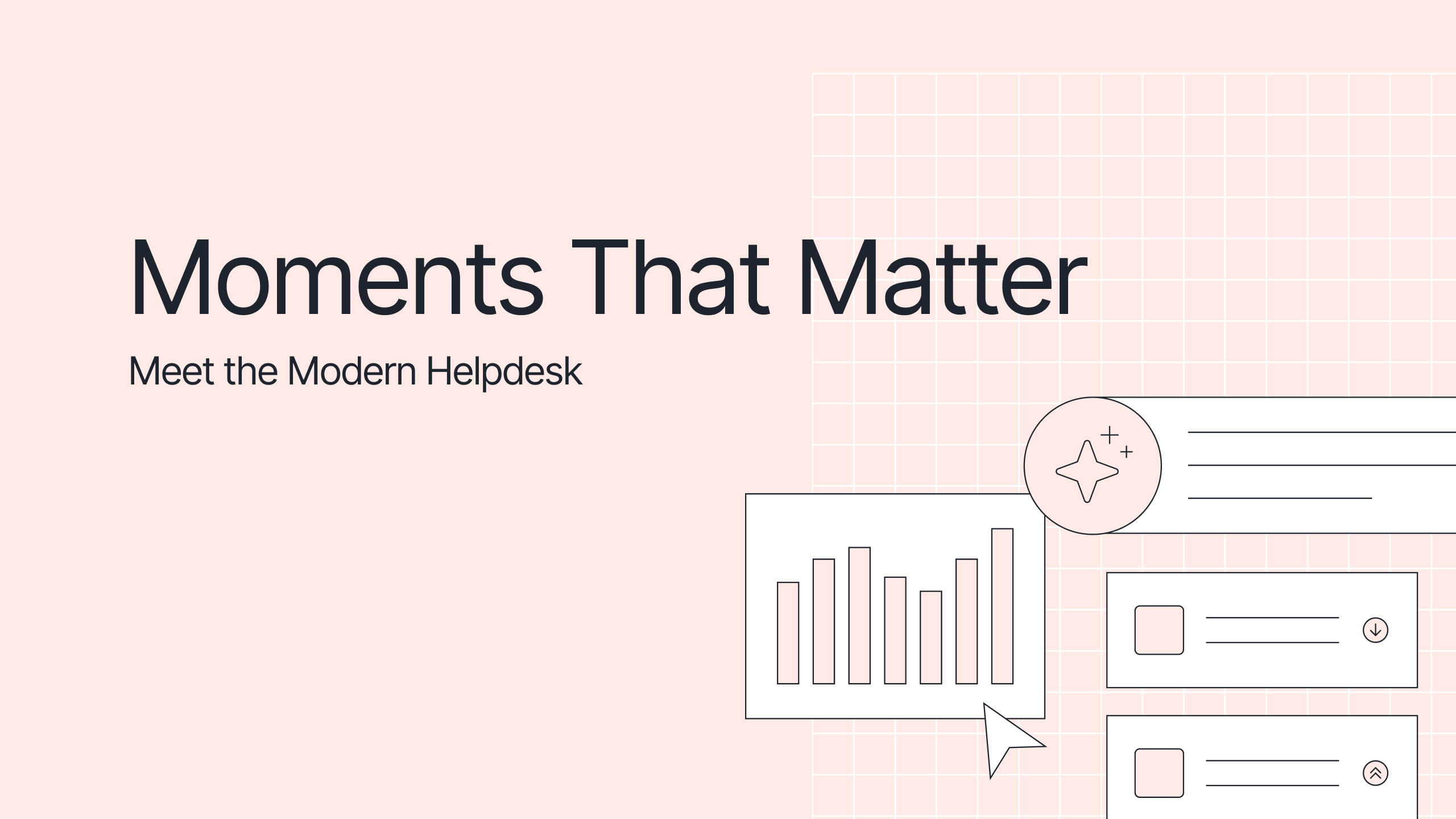

The Updated Gorgias Helpdesk: Built for the Moments that Matter
TL;DR:
- Get instant context with Ticket Summaries. Jump into any conversation without digging through past messages or tabs.
- Organize tickets and customers with Ticket and Customer Fields. Attach properties to tickets and customers to see the whole picture, then turn it into reportable data.
- Support global customers with real-time translations. Engage in natural conversations in your customer’s language without paying for another tool.
- Resolve urgent issues with Priority Scoring. Rank tickets by importance, so high-value or sensitive issues don’t get overlooked.
- Onboard quickly with in-house migration. Whether you’re coming from Zendesk or Richpanel, Gorgias handles the move for you.
We recently unveiled the latest upgrades to Gorgias Helpdesk during Moments that Matter: Meet the Modern Helpdesk.
The event was hosted by Bora Shehu, VP of Product Design, with updates from John Merse (VP of Product), Fraser Bruce (Senior Solutions Consultant), Nicole Simmen (Senior Manager, Customer Implementation), and a customer story from Michael Duran (Operations Manager, Authentic Brands).
From quality of life improvements to brand new features, here’s what’s waiting for you in Gorgias.
Watch the full presentation here:
Support faster with built-in ticket summaries
Agents shouldn’t have to dig for context. Every conversation now comes with Ticket Summaries. Whether an agent has jumped into a ticket mid-conversation or is dealing with a new customer, these AI-generated summaries tell the whole story in no time.
We’ve also given the Customer Timeline a makeover. Now, you can glance at past tickets and order updates in one clean view. Plus, a dedicated Order View lets agents dive into past purchases without leaving the ticket or opening a new tab.
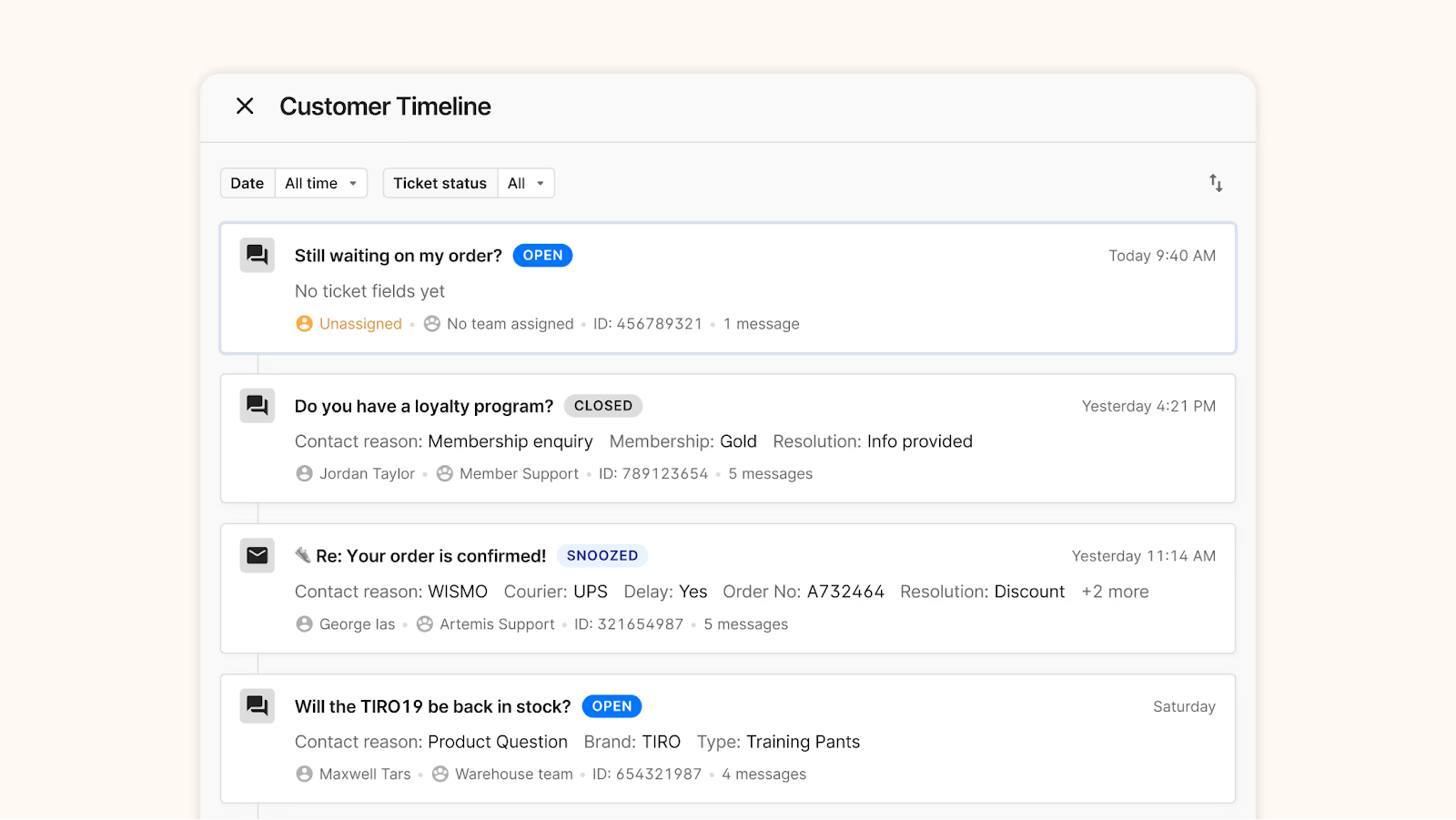
Enrich your data with detailed ticket and customer properties
Agents have always had visibility into customer history, but now that context is easier to act on.
Ticket Fields automatically tags tickets with AI-detected reasons, whether that’s shipping questions or product feedback, to help organize your conversations more effectively.
Then, add in another layer of data using Customer Fields (in beta) to note whether you’re speaking to a longtime, VIP customer or a customer with a history of high returns.
All of this data can be funneled into your ticket reports, making it easier for your team to discover new insights about your products, support quality, and more.

Speak every customer’s language with instant translations
Taking your brand global doesn’t have to mean hiring a whole new team or spending extra on a localization tool. AI-powered translations (in beta) will soon be available on the helpdesk.
Finally, your team will be able to support customers in any language in real-time. Customers write in their native language, agents respond in theirs, and the exchange feels natural on both sides.
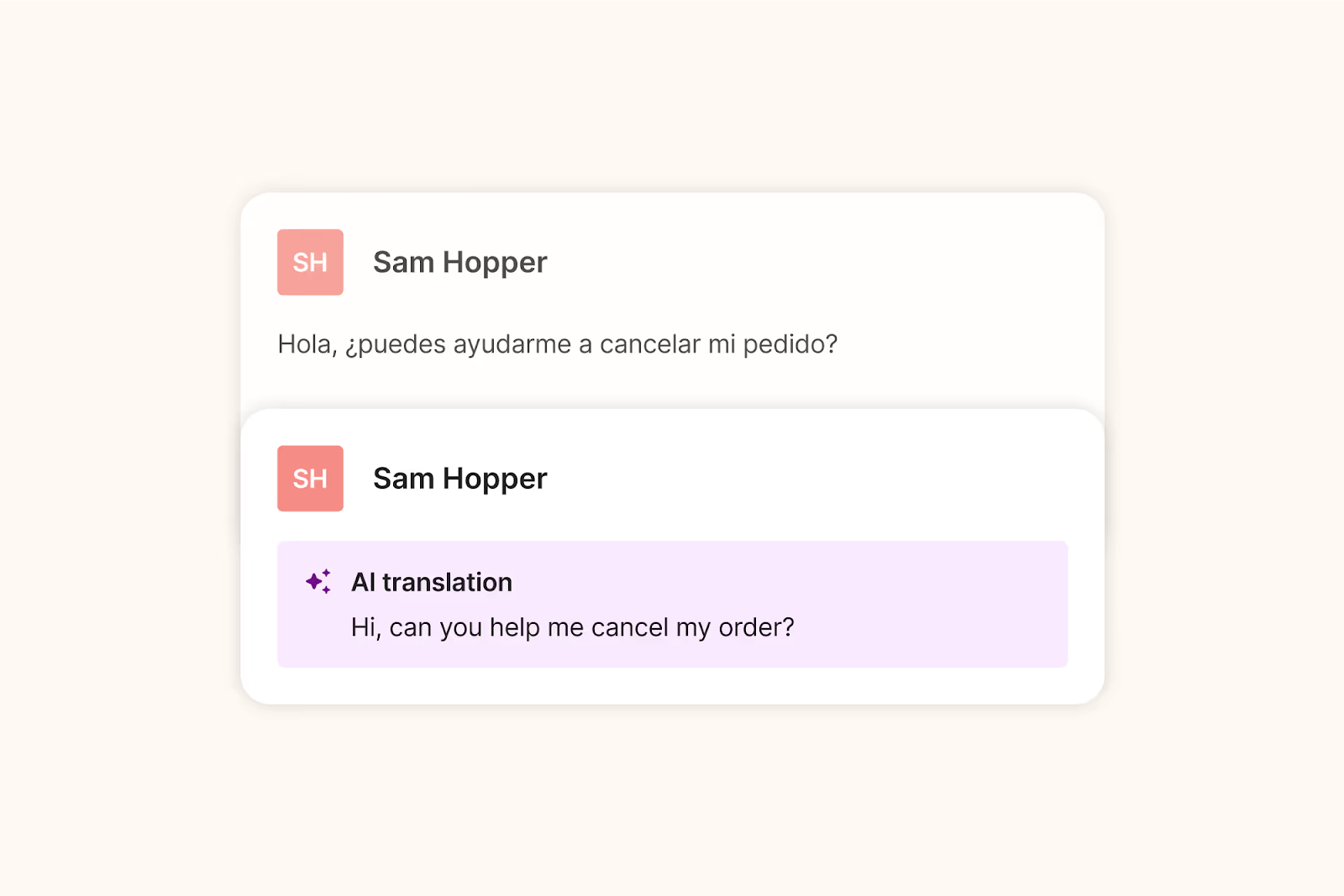
Never miss urgent tickets with Priority Scoring
How many times has an urgent ticket been buried at the bottom of your inbox? The new Priority Scoring system prevents that by automatically labeling tickets as Low, Normal, High, or Critical based on your Rules.
For example, you might label a negative Facebook comment with threatening sentiment as ‘High,’ or bump high-value shoppers to the top with a ‘Critical’ label. This ensures your team always sees the conversations that need the most attention, so no sensitive issue slips through the cracks.
Shape every call journey with the new IVR flow builder
Now in beta, our flow-based IVR (interactive voice response) system lets teams on Gorgias Voice build customized call journeys for every type of conversation. Route customers through interactive menus, segment them based on their data, or direct them to voicemail, and schedule SMS follow-ups and callbacks.
To match agent availability, you can set business hours per phone number and per channel across storefronts. Teams also have more flexibility with ring strategies (ring available agents all at once or one at a time), wrap-up time between calls, and faster availability refreshes.
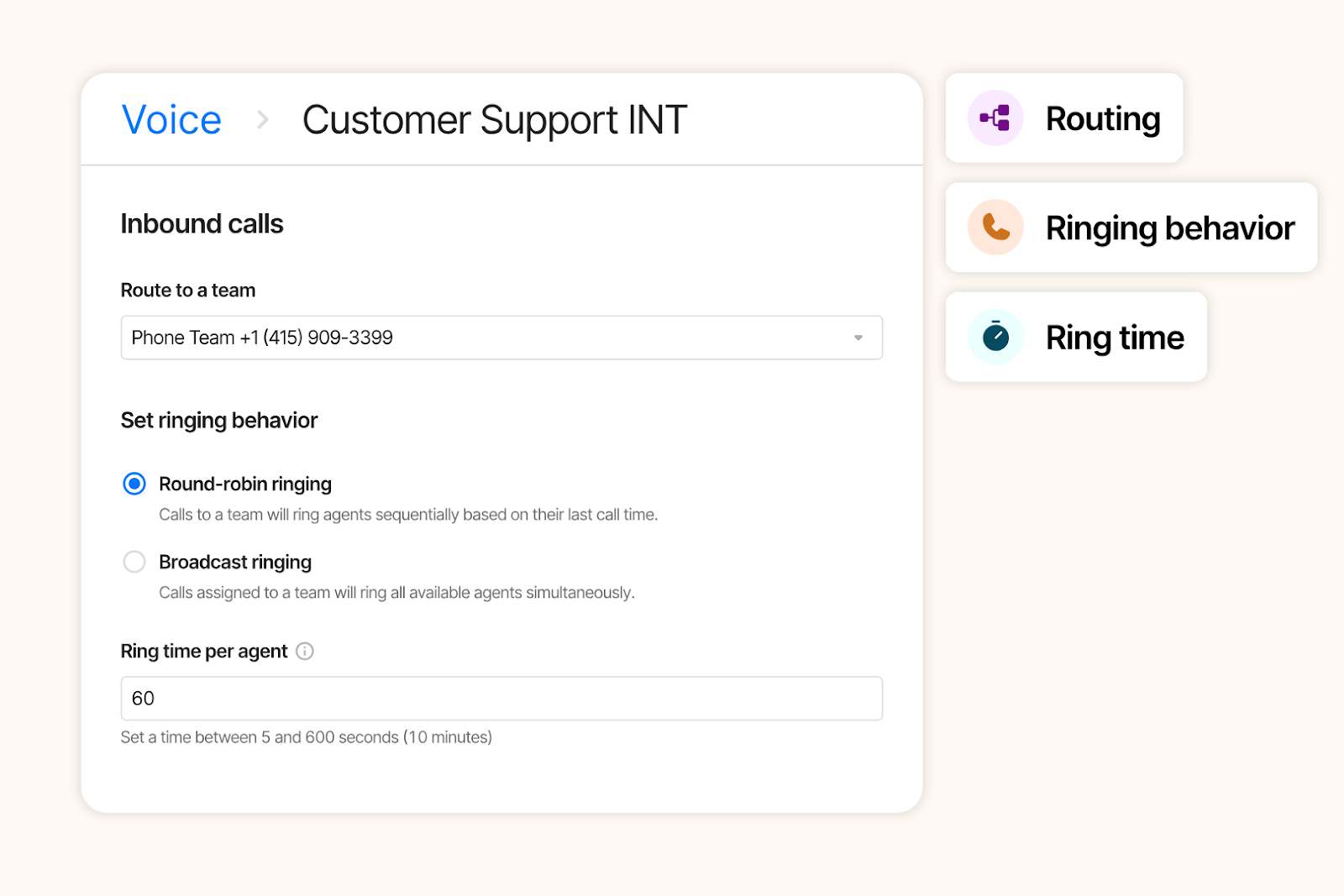
Stay on top of every goal with custom dashboards
We understand that CX teams need more than surface-level KPIs—they need to know what’s actually driving performance, revenue, and retention.
With Dashboards, you can build reports focused on CX data you care about, from agent performance to product return trends. Then, filter by store or sub-brand to zoom in on the details each team is responsible for.
We’re also introducing the Human Response Time metric to show how quickly your team responds to escalations from AI Agent. This gives you a clear sign of what issues require human attention, how fast they’re resolved, and whether you need to adjust staffing.
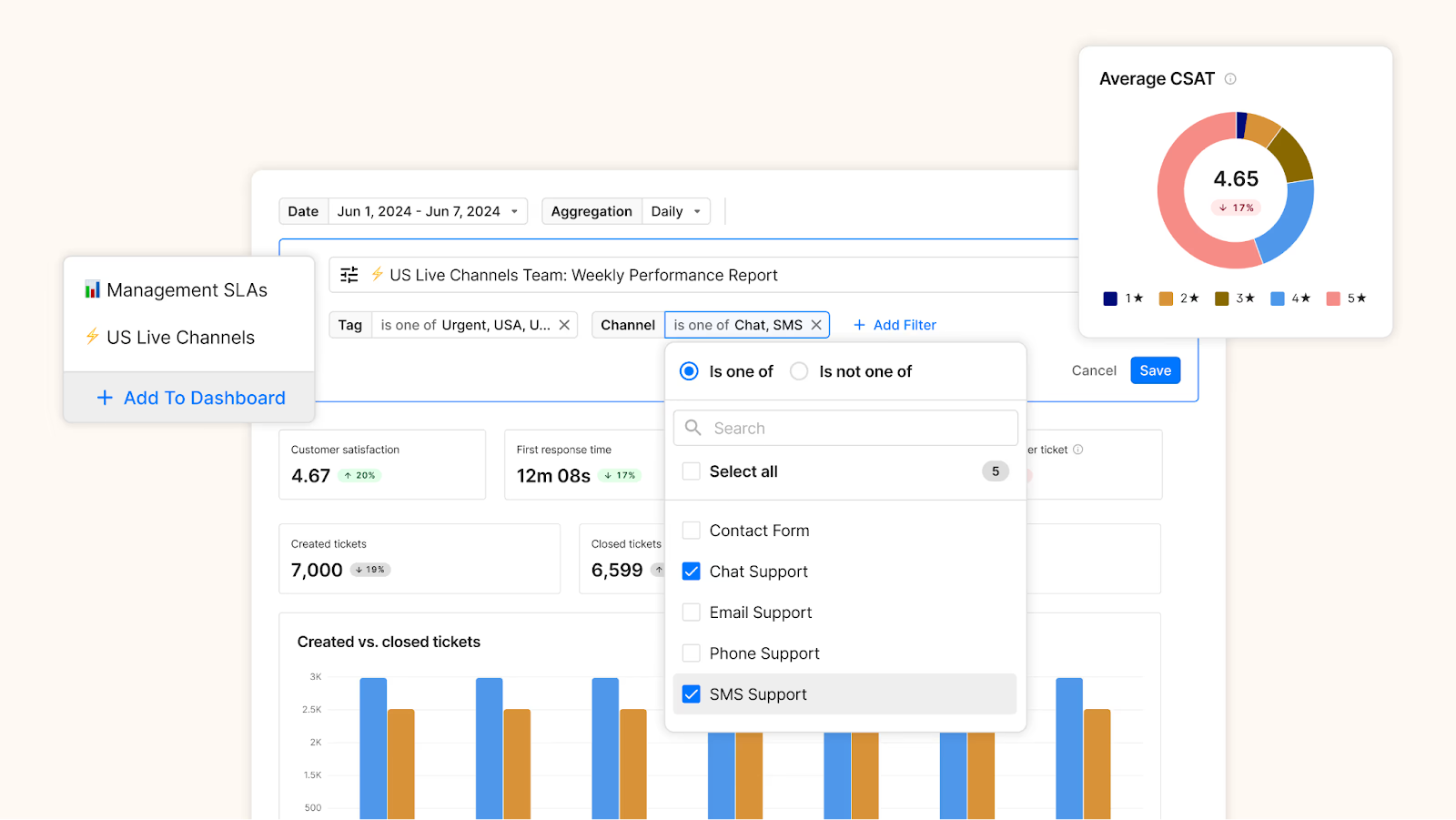
Effortless, in-house migration for new joiners
Leave the moving to us—we now manage migrations in-house. Depending on your plan, our Implementation team will transfer emails, customers, macros, and more for you. Combined with 99.99% uptime, switching platforms is smoother, faster, and more reliable than ever.
For accelerated performance, consider our 50-in-50 implementation program, which aims to resolve 50% of your ticket volume using AI Agent within 50 days.
Enterprise customers receive a dedicated Enterprise CSM, optimization workshops, and 24/7 support to get the most out of Gorgias from day one.
What’s coming next
Our teams are hard at work changing the landscape of customer experience. Here’s what’s on the Gorgias Product Roadmap:
- Cleaner, minimal interface. We’re giving our UI a new look to reduce clutter and highlight key information, making conversations front and center.
- Detailed order view. Quickly view past purchases and make order updates without opening new tabs or interrupting your workflow.
- Shop right in chat. Soon, product photos, descriptions, and even customer reviews will be shown directly in Gorgias Chat, so shopping experiences are as frictionless as possible.
- Scheduled CSV exports. Prove the value of CX with automated exports, perfect for stakeholders, whether they use Gorgias or not.
- New integration with Assembled Workforce Management. Our partnership will help you leverage Gorgias ticket data to optimize forecasting and agent scheduling.
- Role-based access control. Decide which dashboards, views, conversations, and settings can be accessed by each user role.
- Okta single sign-on. Let your team sign in to Gorgias using the same authentication service you use for the rest of your tech stack.
The future of support starts with your helpdesk
Our latest helpdesk updates make it easier than before to create memorable customer moments.
As Bora Shehu, our VP of Product Design, said, “We hope that the tools we’re building help you spend less time on robotic work, and more time on impactful human work that grows your businesses through the power of conversations.”
If you’re not on Gorgias yet and want to see what’s possible, book a demo today.
{{lead-magnet-1}}
TL;DR:
- 58% of fashion shoppers “bracket” orders—buying multiple sizes and returning what doesn’t fit. This drives high return rates, increased costs, and customer frustration.
- 70% of returns are due to sizing issues. Nearly half of shoppers abandon carts over inconvenient returns.
- Leading solutions include: AI-powered fit tools, 3D visualizations that show scale and model stats, “fit finder” tools, at-home fitting experiences, and AI-powered customer support.
- Brands that replicate the fitting room online gain higher retention, lower costs, and stronger sustainability.
Sizing has long been a friction point for ecommerce fashion shoppers.
Without the ability to try items on, 58% of shoppers resort to "bracketing"—ordering multiple sizes of the same piece and returning what doesn’t fit.
While it gives customers a temporary fix, it ultimately creates frustration for them and logistical headaches for brands.
The result is rising return rates, higher costs, and wasted resources. To break this cycle, ecommerce brands need to rethink how they guide shoppers toward the perfect fit. The good news is that many brands are already showing the way by using AI-powered tools and smarter product experiences to replicate the fitting room from the comfort of home.
{{lead-magnet-1}}
Returns are getting unsustainable
Recent data highlights just how severe the return challenge has become for fashion and apparel retailers:
- 46% of shoppers have abandoned a purchase because return methods were inconvenient.
- Fashion and apparel brands get twice as many return requests than any other industry.
- According to Gorgias data, 70% of returns are due to sizing confusion.
- “Will this fit me?” is one of the top reasons customers contact support.
In addition, rapidly rising concerns around sustainability and climate change, as well as heightened awareness around over-consumption, are prompting consumers to make changes in their purchasing habits.
Brands who prioritize well-fitting, long-lasting pieces and reduce carbon footprints and the amount of clothing diverted to landfills by lowering returns can actually benefit from a strategic edge.
“Those who choose to approach sustainability with a long-term mindset even while battling short-term problems will be rewarded with more efficient business operations and a competitive advantage,” writes McKinsey in its State of Fashion 2025 report.
Effective sizing solutions for ecommerce brands
Most brands already have size charts, but shoppers don’t want to measure themselves, or find those charts to be inaccurate.
When shoppers lack confidence in choosing the right fit, they either abandon their carts or rely on bracketing, both of which lower profitability and customer trust.
Forward-looking fashion and apparel brands are solving sizing issues by using tools for a more intuitive shopping experience. This ultimately helps them build loyalty, increase retention, and reduce returns.
Implement AI-powered body measurement tools
Rather than purely providing static size charts on your website, opt for AI-generated personalized fit recommendations instead.
For example, European fashion retailer Zalando reduced size-related returns by 10% using AI-driven advice.
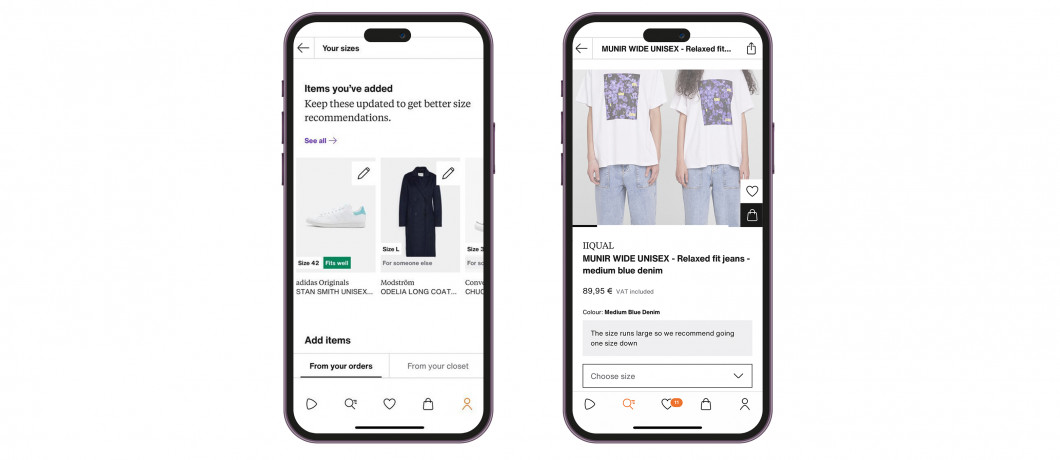
The brand flags whether an item is true to size or not. It also offers the ability for customers to see recommendations based on logged fit-based return reasons, past purchases, and other clothing items that fit them well.
Zalando also launched a body measurement feature in 2023 where shoppers can actually scan themselves for more accurate size advice.
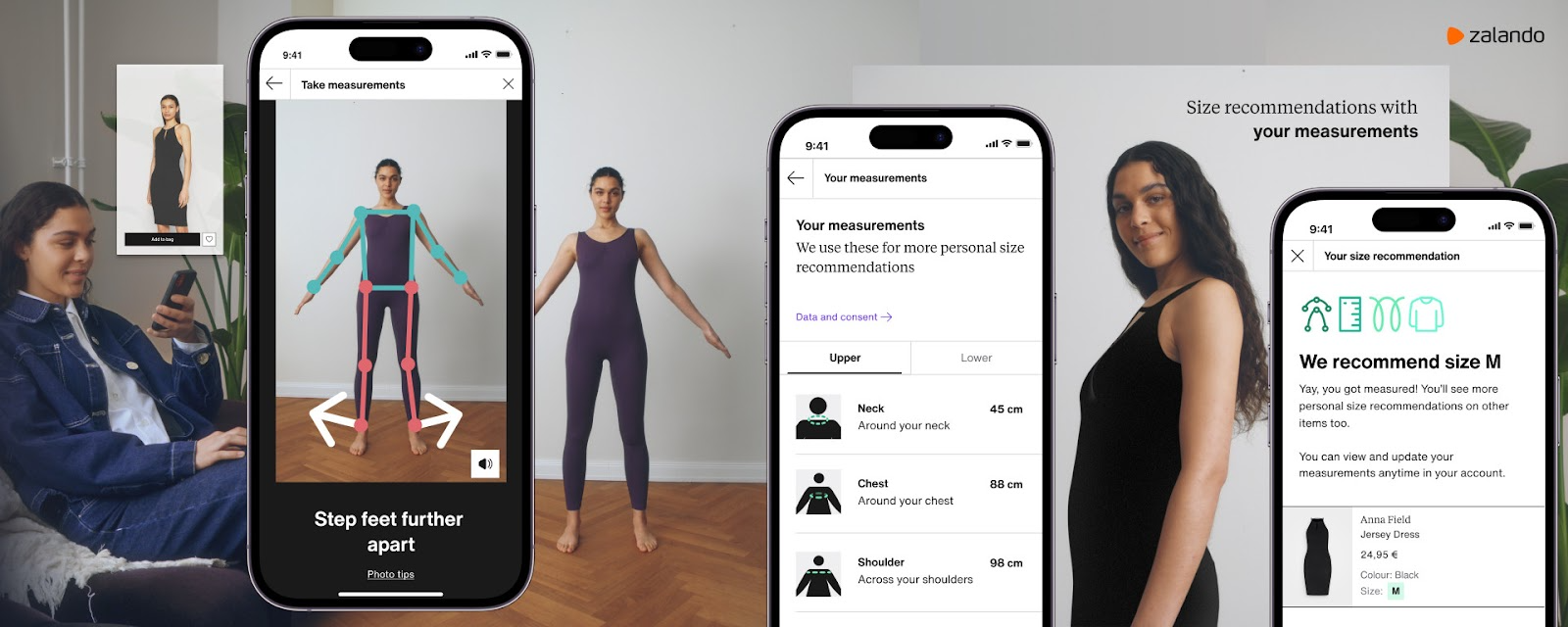
Show size and scale in product photos
As AI grows in proficiency, there are more tools than ever to help shoppers visualize product scale and fit.
For example, accessory shop LeSportsac uses Tangiblee, a product experience tool, to help customers understand scale and what fits inside each bag.
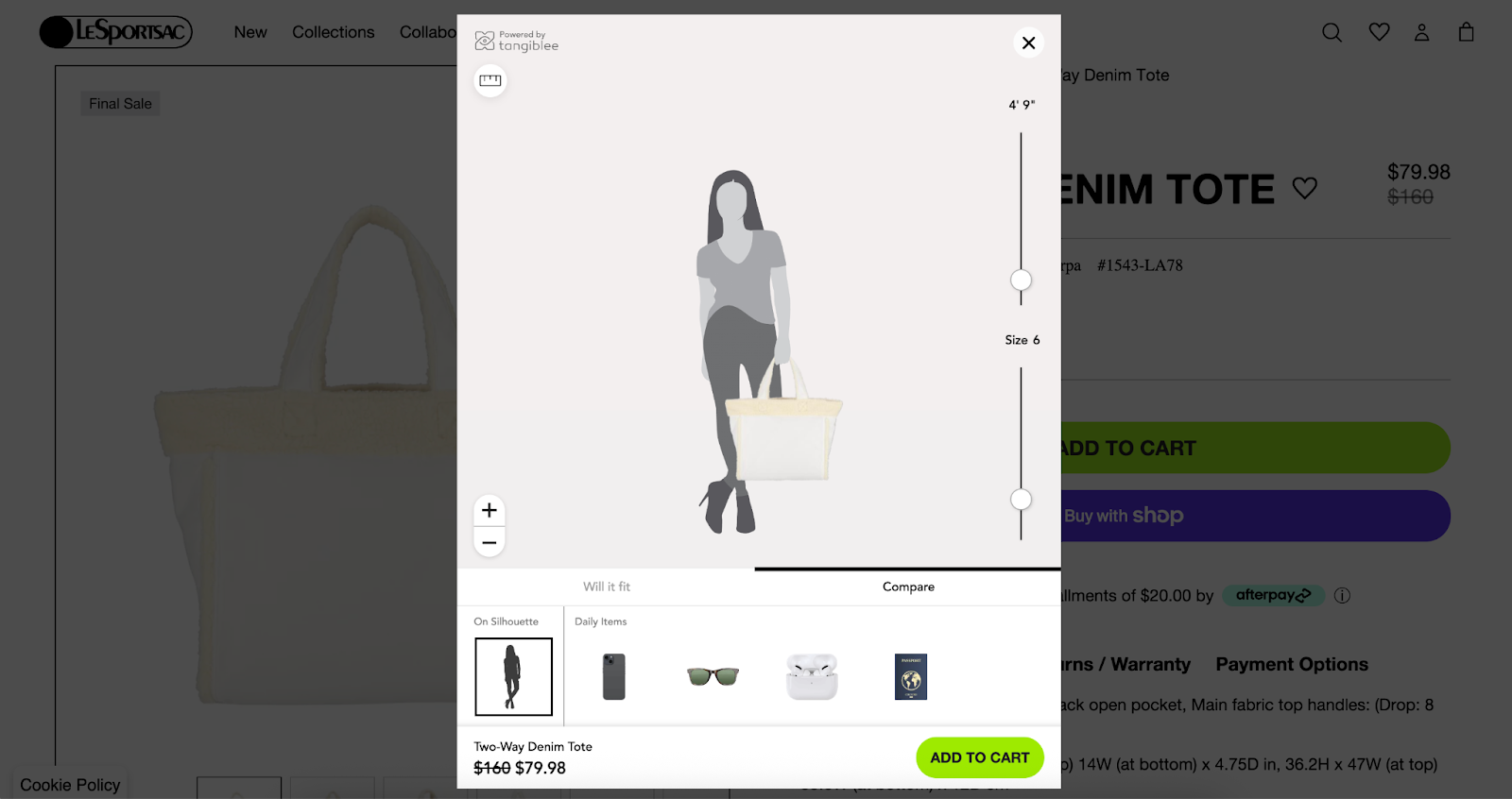
Performance hunting gear shop KUIU takes another approach. It uses a photo-based layering guide, so shoppers can see how the size and fit look with multiple layers on a model. Different model stats shown within product photography give contextual sizing cues.
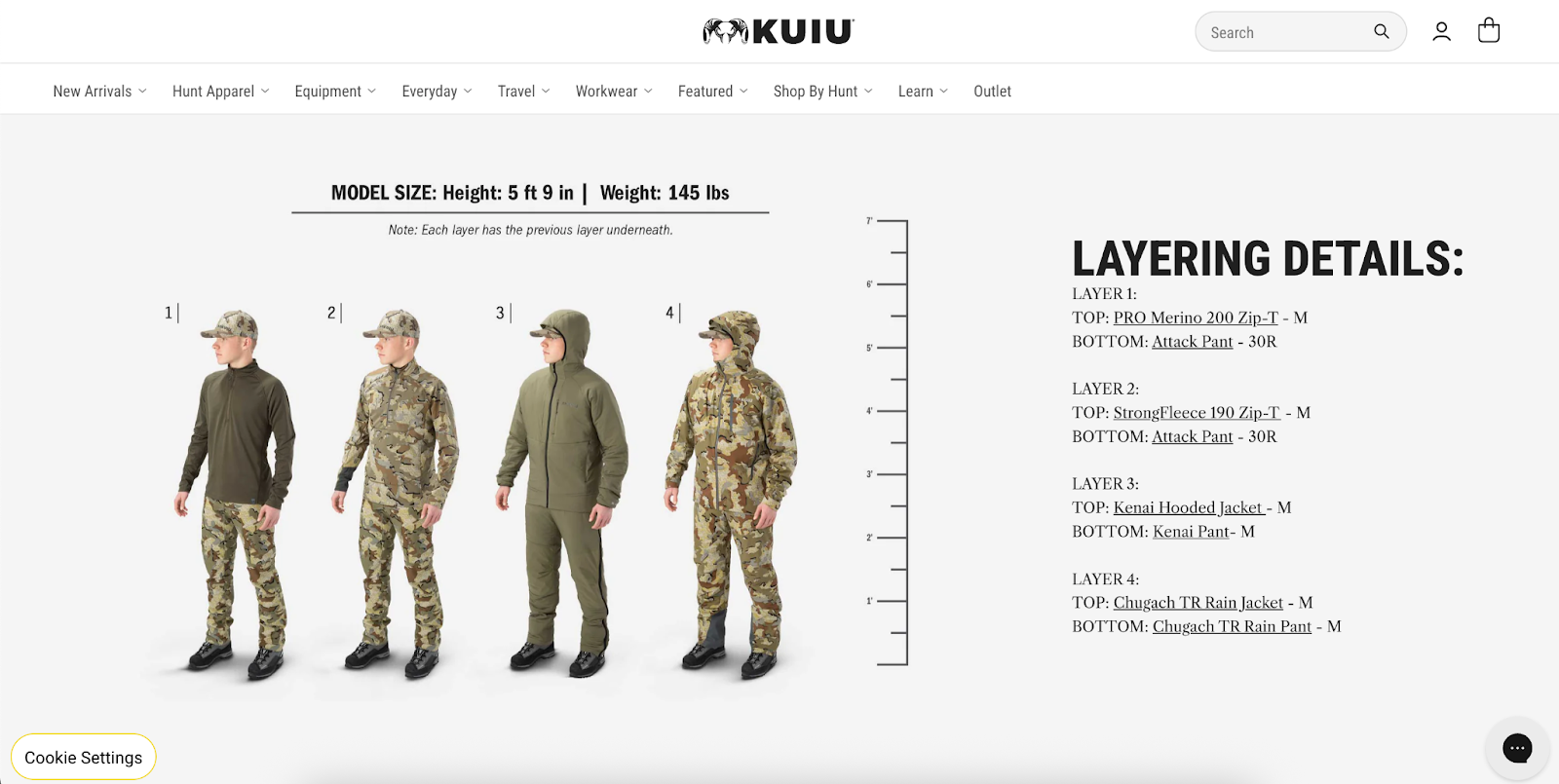
Sleep shop Cozy Earth takes a similar route, stating model height and size on product photos.
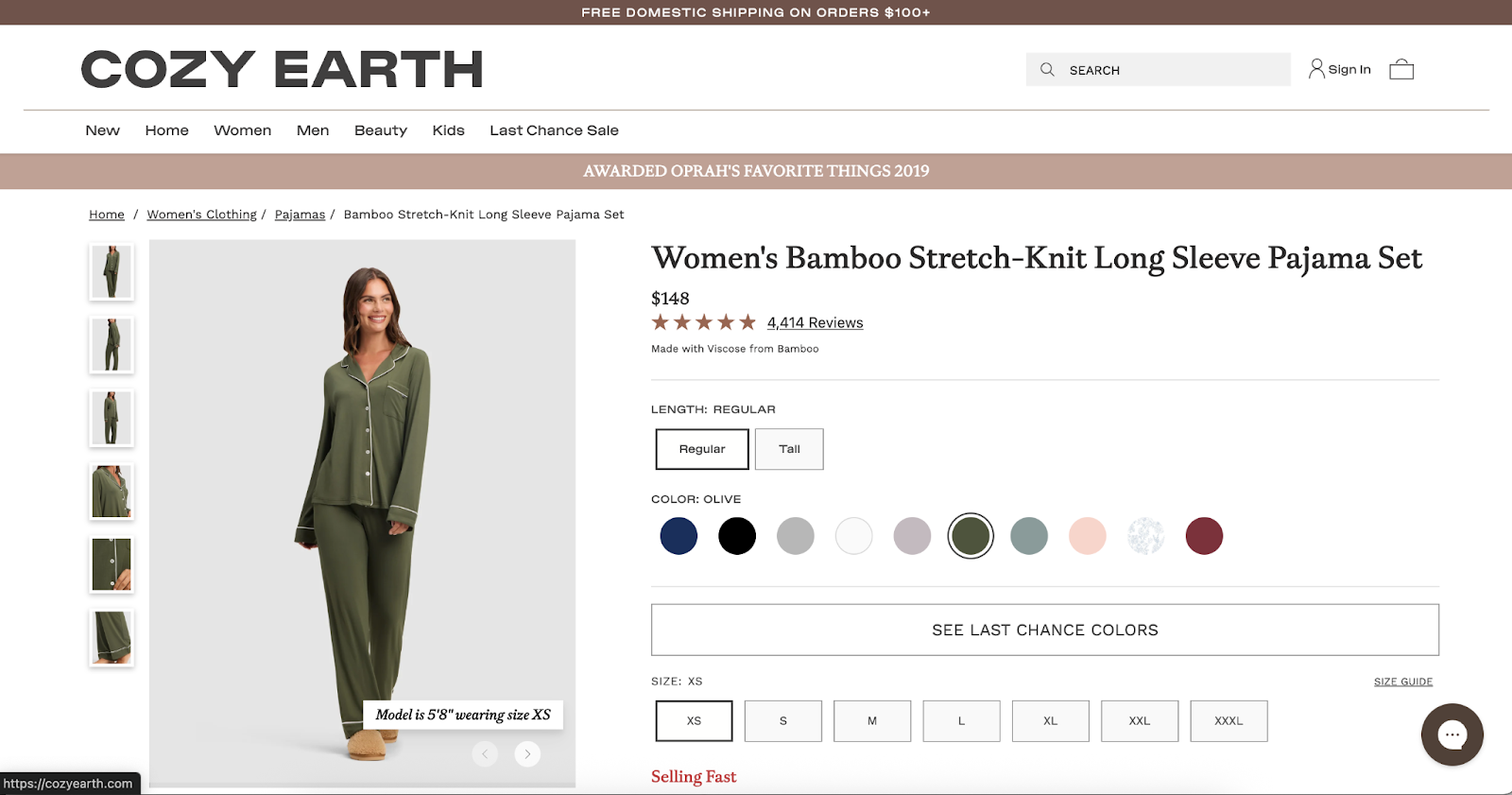
Introduce “fit finder” tools
Some brands are helping shoppers pick the right size with interactive quizzes based on factors like height, weight, and the sizes of other clothing items that fit well. SuitShop is among those brands using a Fit Finder quiz on its website.

Similarly, Psycho Bunny leverages the AI tool True Fit as a size finder on product pages.
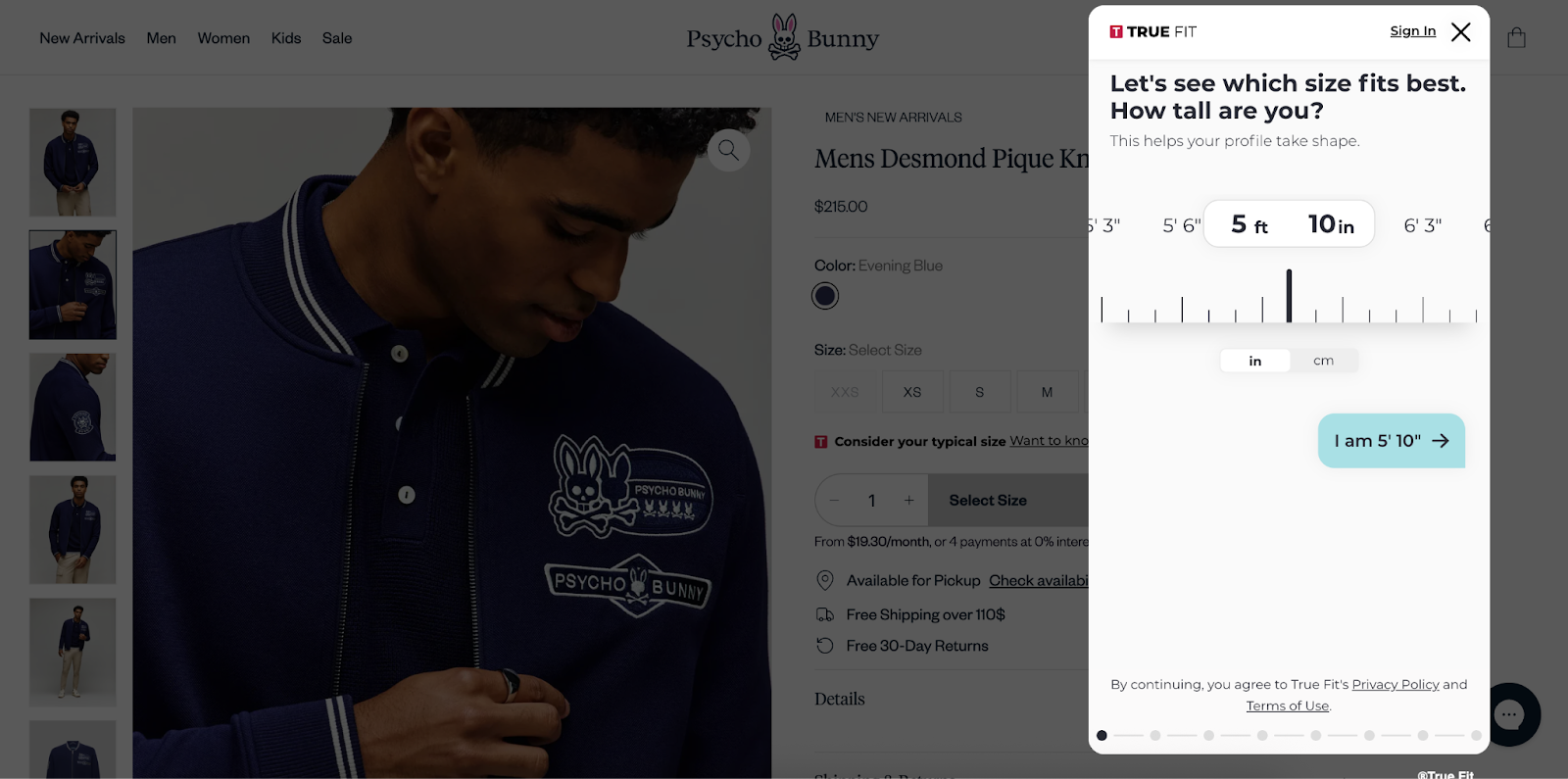
Bring the fitting room home
Ergonomic shoe brand Orthofeet eliminates sizing qualms altogether by including customizable inserts inside each box. Fitting spacers ensure a snug fit and arch enhancement for those who need it, helping shoppers get comfortable shoes that fit.

Jonas Paul Eyewear shares the “try it on at home” approach, offering a free or low-cost home try-on kit.

Leverage AI-powered customer support
Gorgias Shopping Assistant helps brands meet that need by delivering human-like guidance at scale, giving shoppers instant answers that feel personal.
For example, VESSEL uses Shopping Assistant in chat to provide real-time support on sizing and inventory, helping customers choose with confidence. By addressing fit questions directly, Shopping Assistant reduces returns and builds trust at the point of purchase.

Similarly, outdoor clothing retailer Arc‘teryx provides an “ask me anything” AI chat where shoppers can confirm any questions they have around fit or sizing.
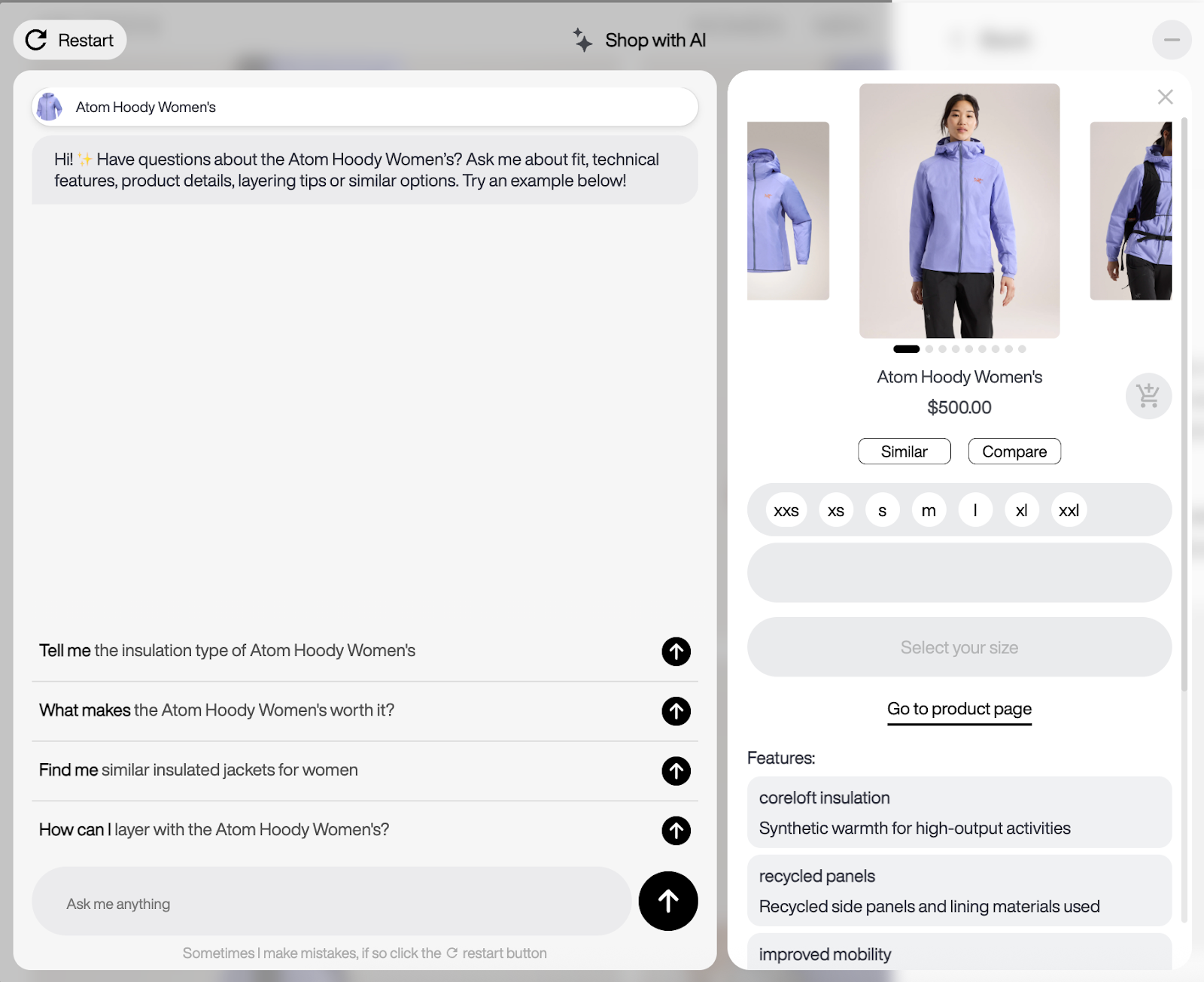
The future for ecommerce size guides
Sizing for ecommerce fashion and apparel brands has become a business-critical challenge. With 70% of returns tied to fit issues and nearly half of shoppers abandoning purchases over inconvenient returns, brands that replicate the fitting room online stand to gain a competitive advantage.
From Zalando’s 10% reduction in size-related returns to VESSEL’s use of AI-powered chat, the path is clear: investing in smarter size chart solutions pays off with higher retention, lower costs, and stronger sustainability.
The brands that provide fitting room-level experiences online now will set themselves apart from the rest.
Book a demo to see how Gorgias, the leading conversational commerce platform, helps fashion brands cut returns, drive sales, and deliver fitting-room level experiences online.
{{lead-magnet-2}}
Newsletter Signup
The best in CX and ecommerce, right to your inbox
Featured articles
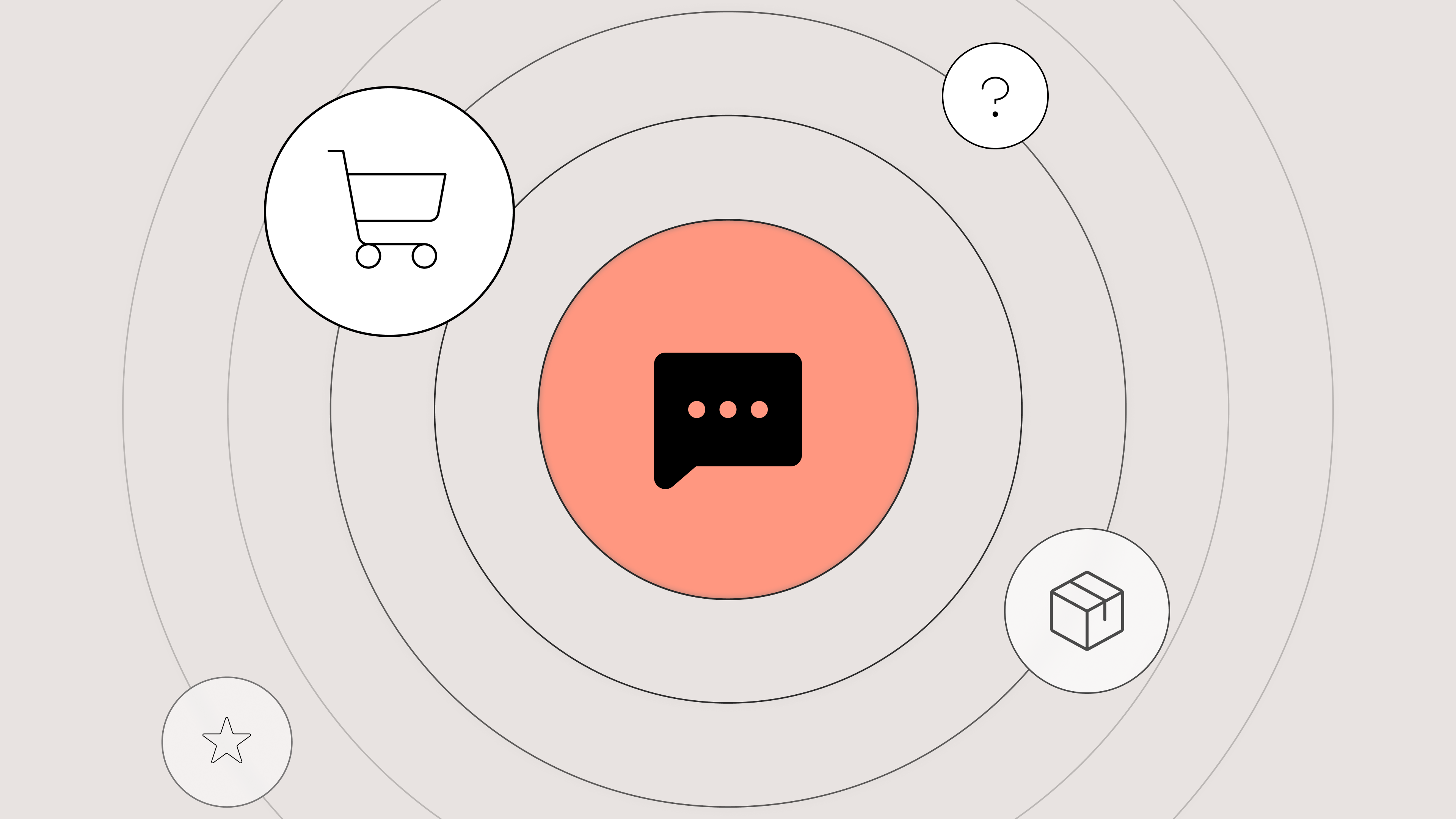
Should You Offer Live Chat Support? A Guide for CX Teams
TL;DR:
- Live chat is the fastest way to help shoppers. It gives customers real-time answers and prevents drop-off.
- You don’t need a 24/7 team to run live chat. Automate FAQs and set clear hours to keep it manageable.
- Live chat improves conversions and customer loyalty. Shoppers who chat are more likely to make a purchase and return to your store.
- Start by automating questions like order tracking and returns. These are easy to answer and make up most of your volume.
- Gorgias makes it easy to launch and scale live chat. You can integrate with your store and go live in under a day.
According to 2025 Gorgias data, chat inquiries are resolved in 24 minutes versus two days on email. It’s no wonder customers prefer live chat over any other support channel.
If you aren’t already offering live chat, it might feel like a big commitment. But when the end product is happier customers, it’s high time to catch up.
Thinking about offering live chat? Learn more about the benefits of live chat customer support, how it differs from chatbots, when and how to use it, and the best live chat tools to use based on your team’s needs.
What is live chat support?
Live chat support is a form of customer service that uses a chat widget to intake customer inquiries. Ecommerce websites, browser-based tools, and mobile apps typically offer live chat in combination with other customer service channels like email, phone, and social media.
Depending on the business, live chat support availability can vary. Some businesses choose to run live chat within their operating hours, while others extend 24/7 availability with the help of automation, conversational AI, or a dedicated off-hours team.
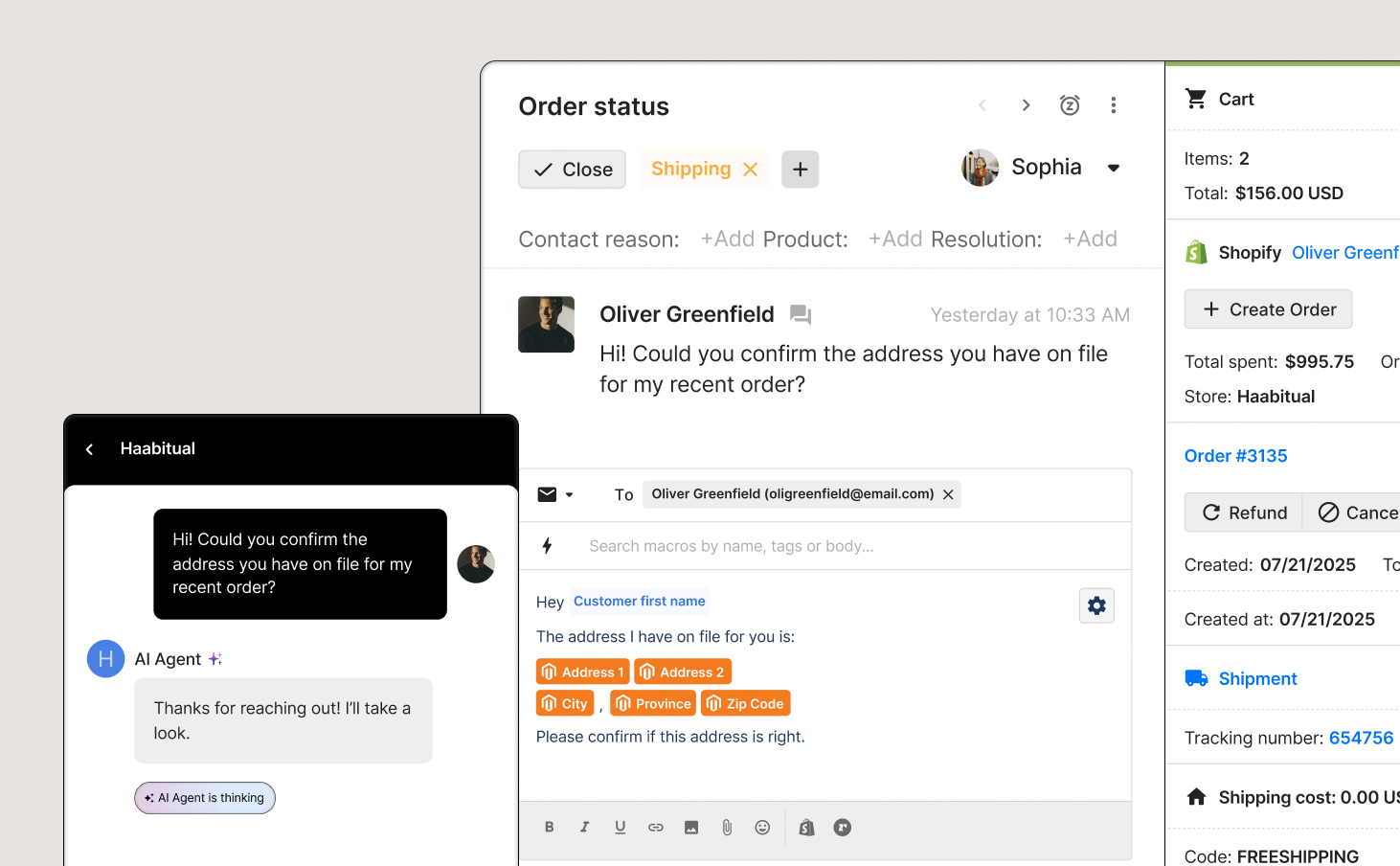
Related: Customer service messaging: Tips and templates for SMS + conversational channels
How does live chat support differ from a chatbot?
The main difference between live chat and chatbots is the option to speak to a live human agent.
With live chat support, customers always have the option of speaking to a live human agent. Meanwhile, chatbots can only provide customers with automated responses, whether preconfigured or generated by AI.
Why should you offer live chat support?
Live chat doesn’t just make support faster—it helps you close more sales.
Aside from quick answers, customers want confidence to buy. In fact, Hiver reports that 63% of consumers prefer live chat over phone and social media, mainly because they get instant answers while they’re still browsing.
Here are the benefits of implementing live chat for your business:
- Customer satisfaction: Customers get the clarity they need while shopping
- Higher conversions: Live chat removes friction at checkout by resolving doubts in real time
- Faster resolutions: Support teams close tickets faster by solving issues right away
- Revenue retention: Agents can recommend the right product, reducing the chance of returns later
Read more: A guide to resolution time: How to measure and lower it
When does live chat make the biggest impact?
Live chat shines in situations where timing directly impacts whether a customer buys your product or walks away. These conversations often happen before a purchase, like when a shopper is deciding between products, has concerns about shipping, or wants to confirm your return policy.
Use live chat in these moments:
|
Moment |
Why Live Chat Works |
|---|---|
|
Before a purchase |
Provides instant product education, assurance, and curbs hesitation due to a lack of information |
|
Order-related concern |
Resolves time-sensitive questions on shipping or changes before the customer bounces |
|
Checkout hesitation |
Reduces cart abandonment by addressing doubts |
|
FAQs |
Deflects repetitive tickets through automation, freeing agents for complex conversations |
|
High-value customers |
Offers high-touch service that reinforces loyalty and drives repeat purchases |
|
Bulk orders |
Accelerates large sales by delivering clarity when urgency is high |
How automation makes live chat support scalable
You don’t need a large support team to offer high-quality live chat support. Sure, live chat can feel risky if you’re a brand with a lean CX team or high ticket volume, but when you automate the right types of conversations, it becomes one of the most impactful support channels.
What to automate first
Start with high-frequency, low-complexity inquiries. These are repetitive questions that don’t require an agent to resolve:
- Order tracking (where is my order)
- Shipping, return, exchange, and cancellation policies
- Basic troubleshooting
- Product education, like sizing or fit guides
These types of tickets typically make up the bulk of your live chat volume. Automating them clears the way for agents to focus on conversations that require more specialized knowledge and nuance.
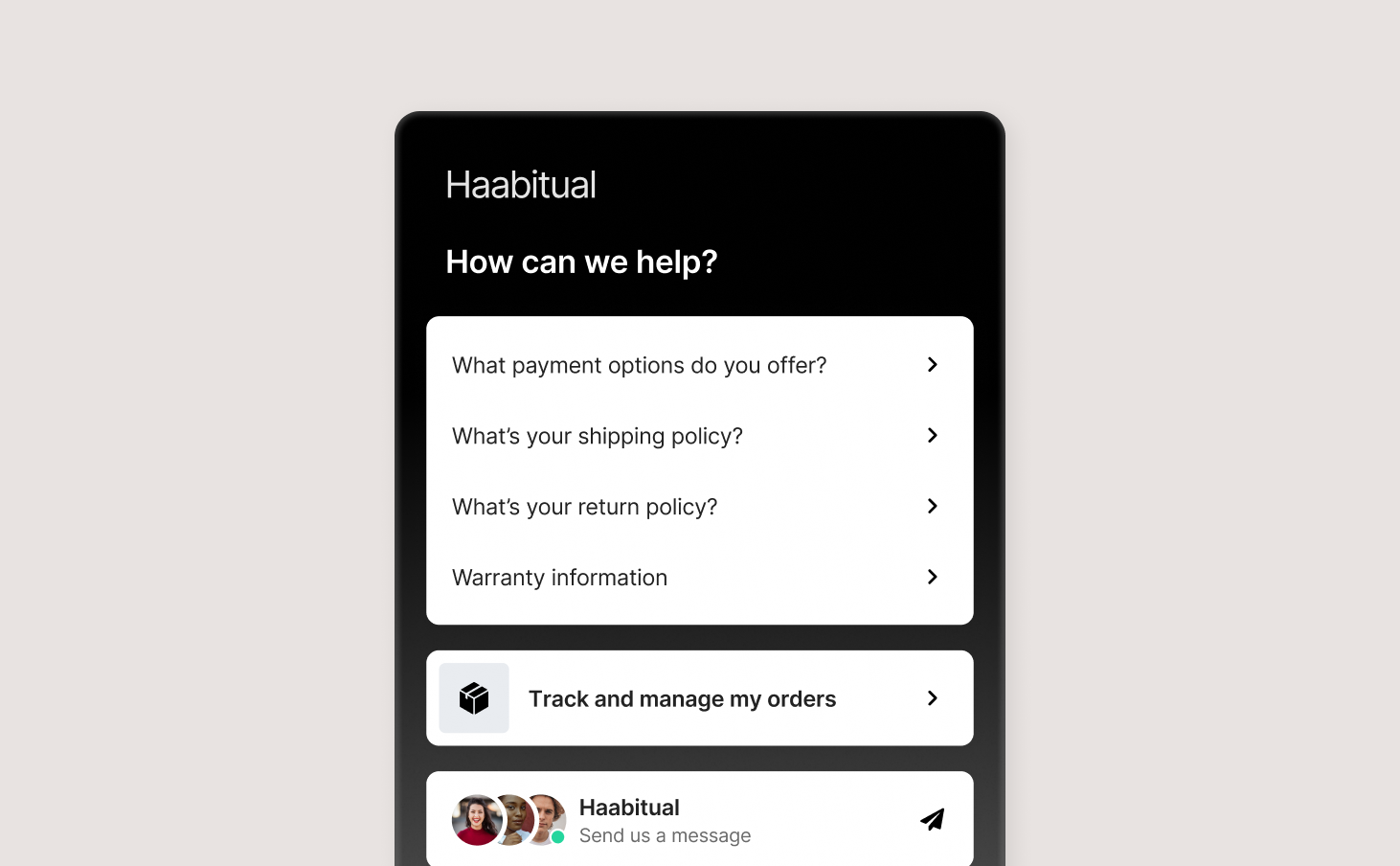
Automation features that help you scale
The best live chat isn’t only a messaging tool, it also comes with features that make the support agents using it more productive.
Here are the top automation features to improve live chat:
- Macros: One-click prewritten replies to common questions that agents can send manually or automatically.
- Customer and product variables: Dynamic details—like name, order number, and delivery date—pulled from your ecommerce platform and inserted into messages can easily make interactions more personalized.
- Flows: Interactive Q&A scenarios that automatically answer customer questions in the chat widget.
- Routing: Prioritize or assign tickets to agents based on topic, urgency, or language for maximum efficiency.
- Conversational AI: Leave live chat on 24/7 with tools like Gorgias AI Agent to answer repetitive questions and update orders—even when your team is offline.
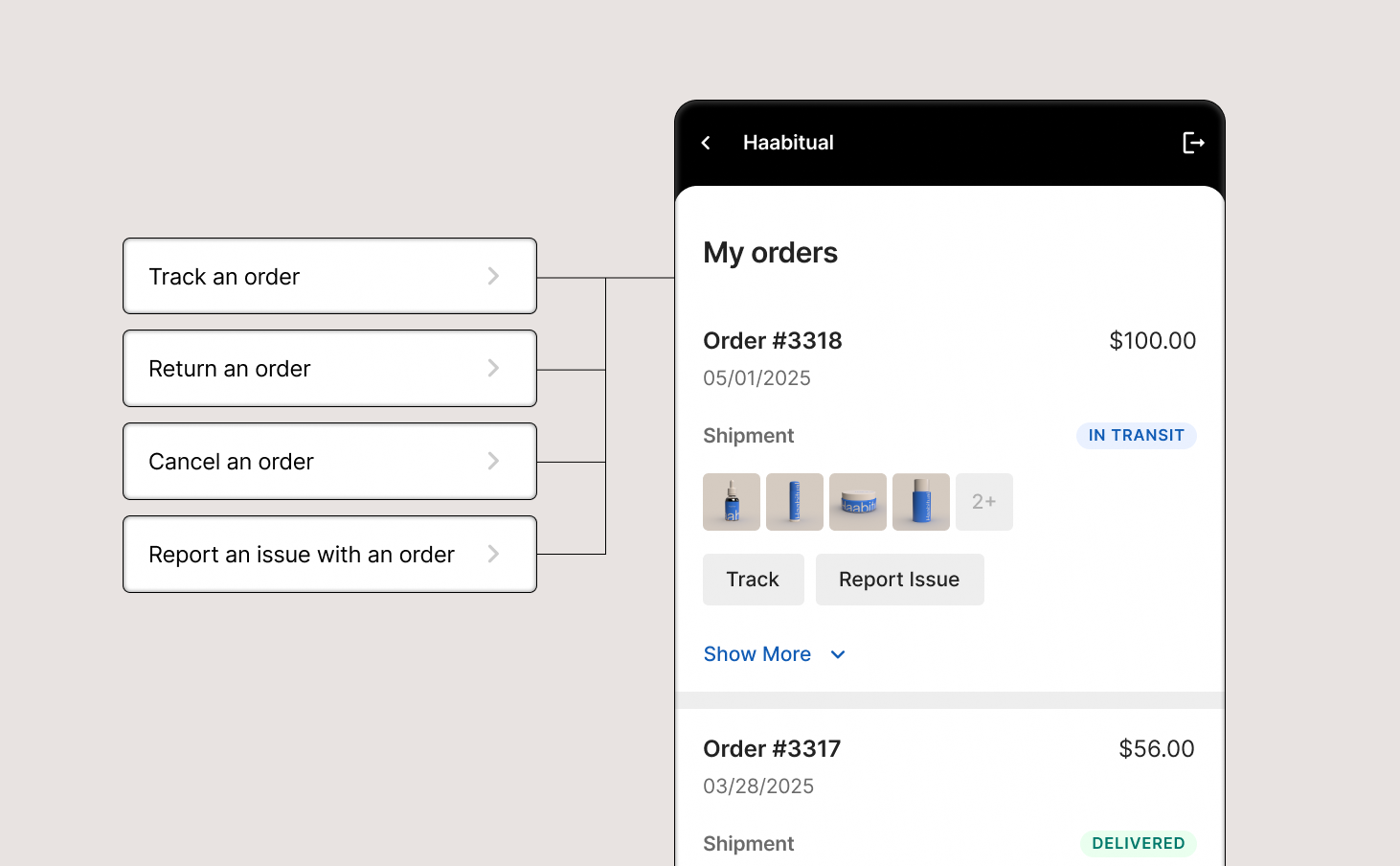
The dos and don’ts of replying to a live chat message
Good live chat messages are quick, helpful, and easy to follow. Poor live chat messages are slow, robotic, or long-winded.
Follow these guidelines to help keep your replies effective and consistent:
|
Do ✅ |
Don’t ❌ |
|---|---|
|
Respond within your target SLA |
Leave customers waiting |
|
Keep responses concise |
Send long, wordy messages |
|
Use macros and templates as a starting point |
Manually type everything again and again |
|
Ask clarifying questions |
Assume you understand everything |
|
Be transparent if you need more time |
Promise something you can’t deliver |
|
Confirm resolution before ending the conversation |
End the chat without checking if the issue is solved |
How to set up live chat without overwhelming your team
Adding live chat for the first time or want to make your current setup more manageable? Start with these five steps:
1. Set live chat hours
You don’t need to be online at all times to offer live chat. Start by choosing live chat hours that reflect your team’s availability and peak shopping hours.
Remember to display your availability on your website clearly to manage customer expectations.
2. Prioritize live chat tickets in your inbox
Customers who reach out to you via chat are active on your site and often close to purchasing.
Create rules in your helpdesk that flag live chat conversations as urgent, so they don’t get buried under slower channels like email. If you have a dedicated agent who handles chat, route all chat tickets to them for instant visibility.
3. Automate your first reply
Set up an auto-response that triggers immediately when someone starts a chat. Even a short message like “Hey! Thanks for your message, an agent will be right with you,” can reduce drop-off and give your team time to prep.
4. Edit your macros for live chat
Templates that work in email may be too wordy in chat. Shorten your macros, simplify the tone, and make sure each response fits cleanly into a chat window. Use dynamic variables to pull in details like order number or shipping status without slowing down your agents.
5. Capture customer emails when live chat is offline
Customers don't stop having problems when your team clocks out. When someone tries to chat outside business hours, collect their email so an agent can follow up once your support team is back online.
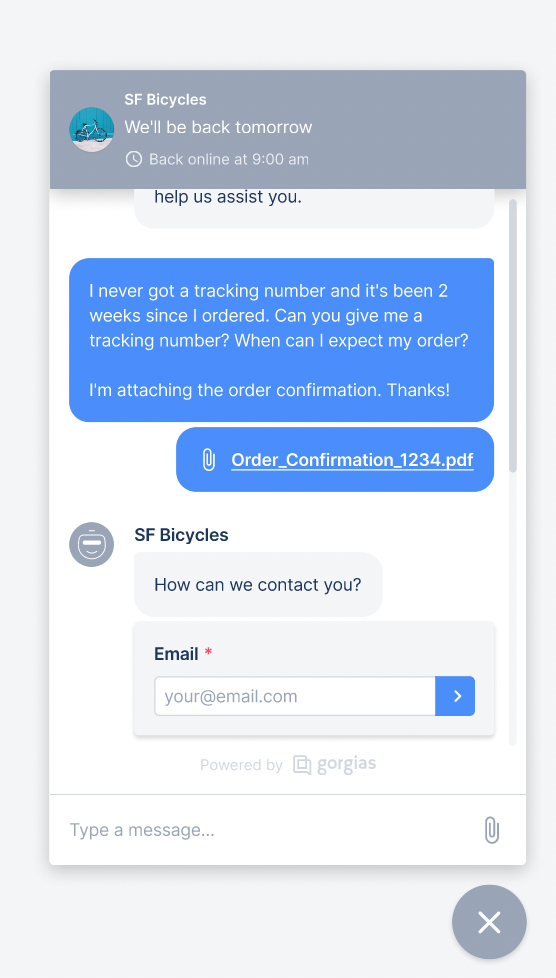
Best live chat tools for CX and support teams
If you’re evaluating live chat software, here are five solid options to start with. Each one fits different team sizes and priorities.
|
Tool |
Pricing Model |
Best For |
Standout Feature |
Limitation |
|---|---|---|---|---|
|
Gorgias |
Per ticket |
Ecommerce brands |
Conversational AI that handles support and drives sales with upsells, recommendations, and context-aware discounts |
Limited AI features for non-Shopify ecommerce stores |
|
Zendesk |
Per user |
Large CX teams with dev resources |
Highly customizable for large support orgs |
Built for general use, not ecommerce; limited email AI; high setup cost |
|
Intercom |
Per user |
SaaS and product companies |
Built-in onboarding and product messaging tools |
Not ecommerce-focused; limited integrations and high AI cost |
|
Tidio |
Per ticket |
SMBs looking for budget automation |
Affordable chatbot + live chat combo |
Lacks visual upsell tools and struggles with complex sales questions |
|
Richpanel |
Per user |
Early-stage teams |
Simple UI and fast time to launch |
Buggy UI, no AI Agent, slow updates, poor Shopify automation |
Deliver faster support without adding headcount
Gorgias helps ecommerce brands deliver fast support without cutting into your budget. Automate common questions with conversational AI, resolve tickets in seconds, support and sell, and give your team the context they need to handle complex conversations with one tool.
Want live chat that takes support to the next level? Book a demo.
{{lead-magnet-2}}
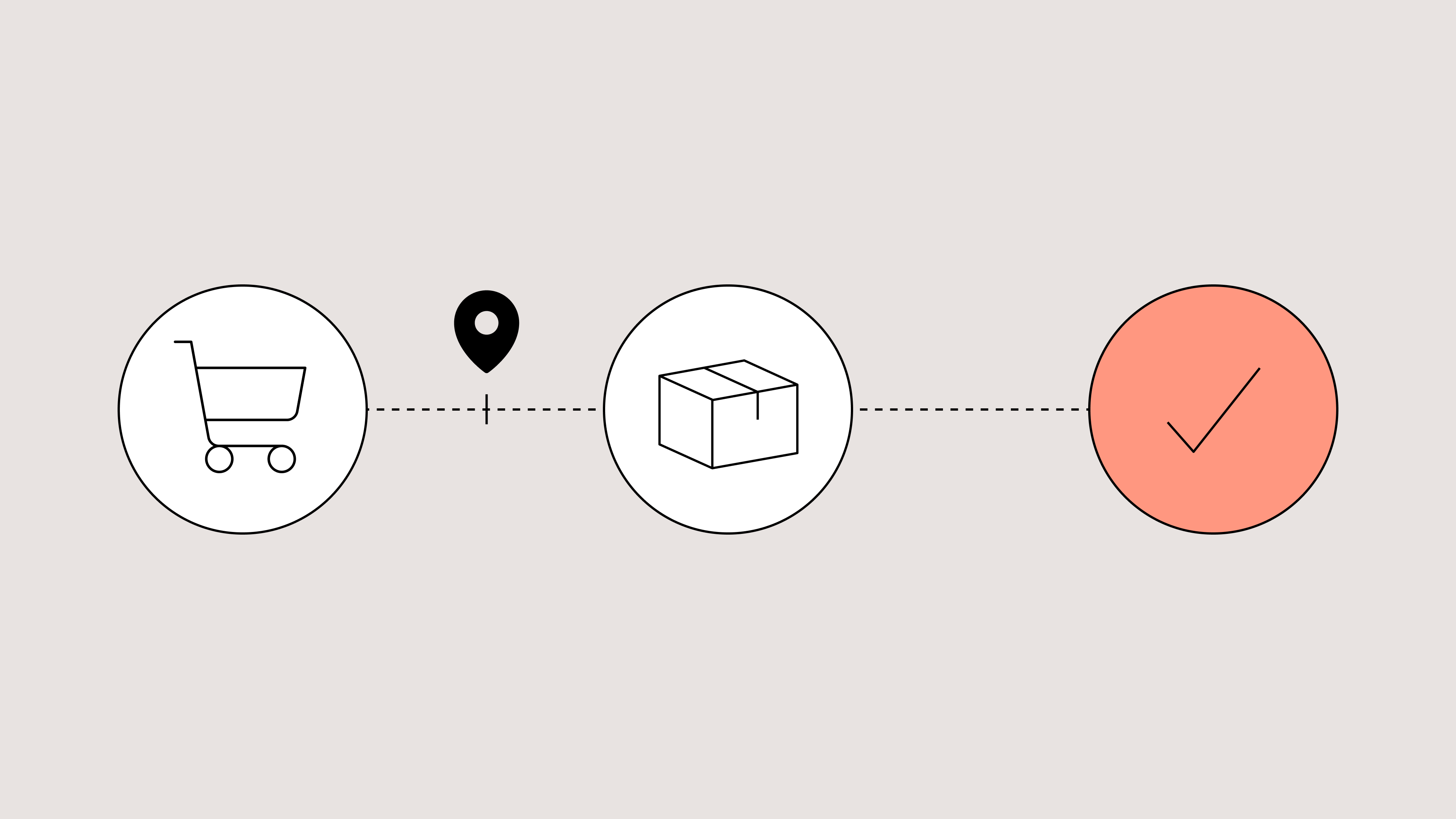
The Complete Guide to Tracking Customer Orders on Shopify
TL;DR:
- Customers expect real-time order tracking. Allow customers to track their orders from anywhere—from their email to your website—at any time to increase their sense of security, reduce returns, and build trust.
- Helpdesk + order tracking = efficient. Choose a solution like Aftership, ShipBob, or ShipStation that integrates with your CX platform. This lets you link shipping data with your customer data, resulting in faster support.
- Offer self-service tracking options. Ensure your shipping information is easily accessible to customers through email, live chat, SMS notifications, and on your website.
Today, order visibility is table stakes. Around 50% of consumers actively track their order status to confirm it's progressing smoothly and staying on schedule.
Whether it’s order anxiety or excitement, shoppers want to see their order's status and location at any given time. Even better when they can get real-time alerts via SMS or at each point in an order’s journey.
So if you haven’t set up order tracking yet, now’s the time, because your customers already expect it. Here’s everything you need to know about the benefits of tracking customer orders and how to implement an order tracking tool for your Shopify store.
{{lead-magnet-1}}
Why is order tracking so important for ecommerce?
Ecommerce vendors like Amazon have normalized order tracking. Today, most, if not all, customers expect to know where their order is.
Offering real-time tracking data for orders benefits both your customer and your business in five distinct ways:
- Peace of mind: Real-time tracking reassures shoppers and helps businesses monitor fulfillment.
- Fewer support tickets: Cuts down WISMO inquiries (18% of tickets) with automated updates.
- Lower returns: Accurate timelines reduce late-delivery returns and protect revenue.
- Stronger loyalty: Reliable tracking builds trust. Late or incorrect deliveries push shoppers away.
- Easy planning: Consumers need to know that an order is on its way to plan their day.
Recommended reading: Ecommerce returns: 10 best practices for taking your online store to the next level
How to set up order tracking for your Shopify store
Here’s how to set up order tracking for Shopify stores:
- Choose an order tracking tool
- Integrate your order tracking tool with Shopify
- Configure your order tracking app’s settings
- Integrate your order tracking app with your CX platform
As an example, we’ll show you how to set up order tracking on a Shopify store with AfterShip Tracking.
1) Choose an order tracking tool
First, choose an order tracking tool like ShipBob, ShipStation, or AfterShip. These tools pull order information, tracking numbers, and shipment status to generate shipping updates for your customers.
Pro Tip: It’s best if your order tracking app integrates with your helpdesk, so that you can offer faster, context-rich customer support.
Read more: 12 best shipping software tools for ecommerce stores
2) Integrate your order tracking tool with your ecommerce platform
Install your order tracking app of choice via the Shopify App Store. For us, it will be AfterShip Tracking.
To complete the integration, go to the AfterShip Tracking dashboard. Click Apps > View more apps > Shopify > Install app. You’ll be redirected to your Shopify settings. Read through the privacy and permission details and click Install app.
Pro Tip: Not sure if you did it correctly? Your store URL will be labelled as “Connected” on the Shopify connection page.

3) Configure your order tracking app’s settings
Time to load your order tracking app with your Shopify data. This is a crucial step to ensure your app uses your courier and order details.
On Aftership Tracking, go to Apps > Store connections > Actions to set up these two actions:
- Courier Mapping: This matches shipping company names between Shopify and AfterShip so tracking data flows correctly even when the same carrier has different names in each system.
- Auto-import settings: This controls which orders automatically sync from Shopify to AfterShip based on criteria like date range, payment status, and fulfillment status, so you only track the orders you want.
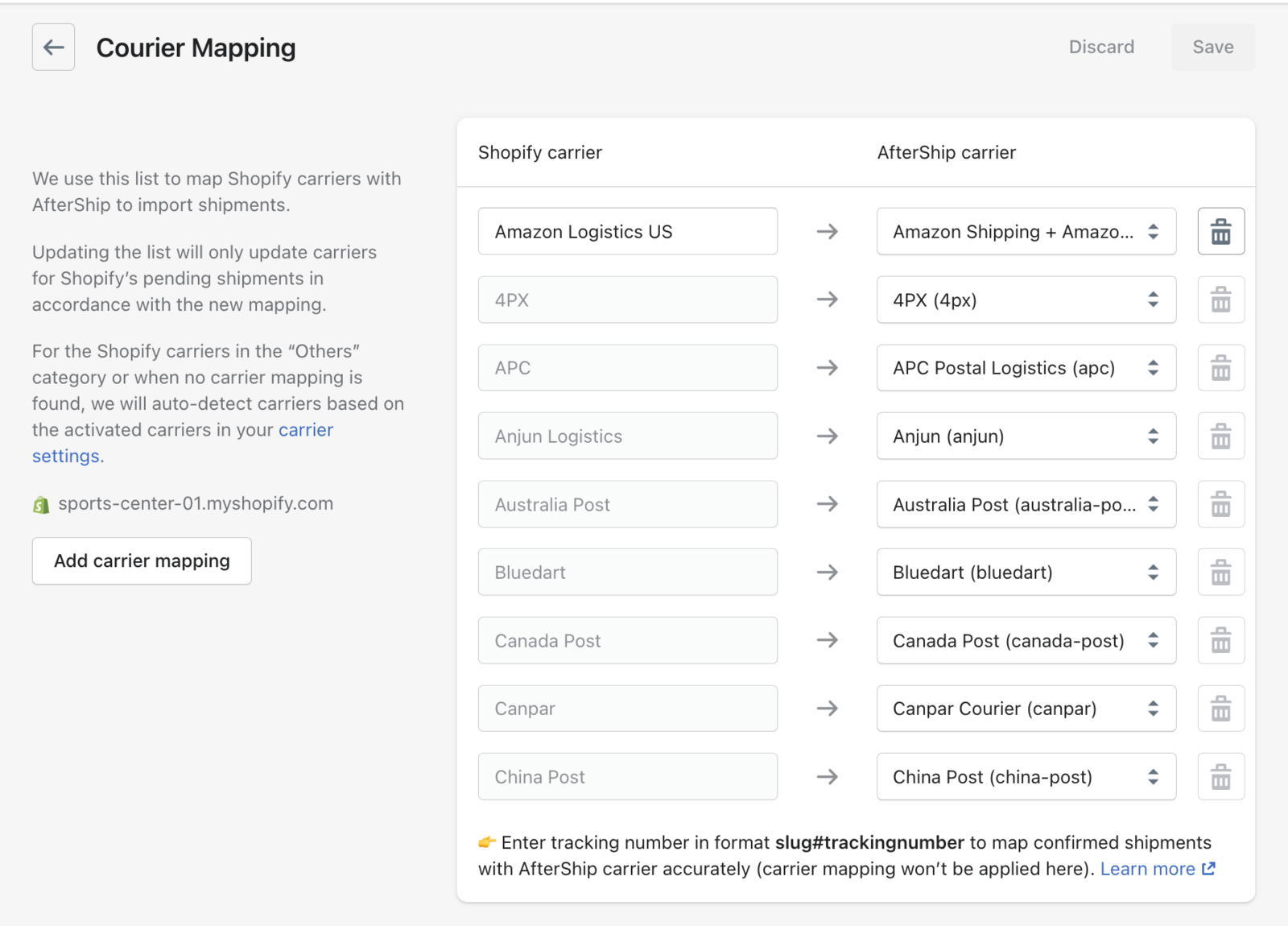
4) Integrate your order tracking app with your CX platform
Finally, connect your order tracking app to your helpdesk.
When customer messages, shipping data, and tracking information are connected, your team can:
- Get the full context with instant access to tracking numbers, shipping addresses, and estimated delivery dates
- Eliminate the need to switch tabs or copy/paste information between tools
- Resolve customer inquiries faster
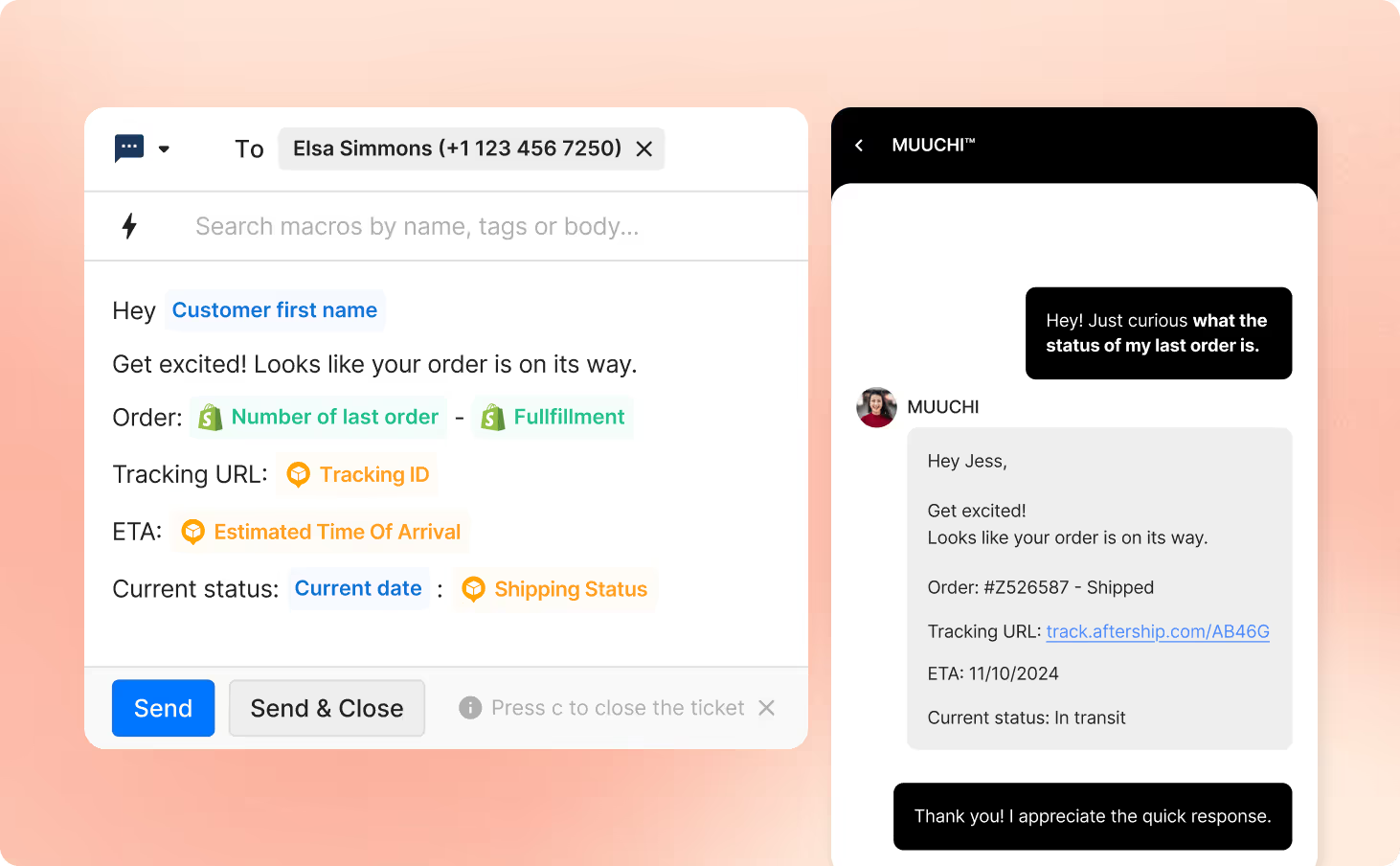
Read more: How to connect AfterShip Tracking to Gorgias
The 6 key spots to add ‘Track My Order’
It’s important to make order tracking accessible to customers, wherever they are. And since more than 68% of orders are done through smartphones, it’s critical to design every tracking touchpoint with a mobile-first experience in mind.
Order tracking should be available in:
- Emails (order confirmation and automated replies): Include the receipt, tracking number, and a link to the tracking portal. Automated replies should also provide updates when customers ask about order status.
- SMS: Send the tracking number and portal link. Use for delivery updates, delays, or exceptions.
- Conversational AI in chat: Provide the order status, tracking number, and delivery estimate directly in the response.
- Self-service order management: Add a “track my order” button in the chat widget with order status, tracking number, and delivery date.
- Help Center (FAQ page): Embed a tracking tool where customers can enter their order number or email to see status and carrier tracking.
- Account portal: Show fulfillment status, tracking number, and carrier link in the “My Account” section for each order.
What are the best order tracking apps for ecommerce stores?
Depending on your needs and the ecommerce platform you use, choose from options that are both scalable and flexible.
ShipBob
ShipBob is a global logistics platform that helps ecommerce brands provide fast, affordable shipping and best-in-class order fulfillment. Its connected technology and fulfillment network improve delivery times, reduce costs, and elevate the customer experience.
Standout features:
- Distributed global fulfillment centers shortens delivery times
- Real-time inventory management and order tracking
- Affordable shipping rates through carrier partnerships
- Analytics tools to optimize fulfillment and logistics performance
Check out ShipBob in the Shopify App Store or the BigCommerce App Store.
AfterShip
AfterShip is a shipment tracking and notification platform that helps ecommerce brands keep customers informed and improve delivery transparency. It streamlines post-purchase communication and makes it easier to spot delivery issues before they affect customer experience.
Standout features:
- Seven customizable notification triggers (e.g., in transit, out for delivery, delivered)
- Easy-to-use email editor for branded tracking updates
- Filter and monitor tracking data to detect delivery issues early
- Branded tracking pages that keep customers on your site
- Detailed analytics to measure delivery performance and customer engagement
Check out AfterShip in the Shopify App Store and the BigCommerce App Store.
ShipStation
ShipStation is a shipping software solution that helps ecommerce businesses save time and money by comparing carrier rates and delivery times in one place. It automates shipping workflows to ensure customers get fast, cost-effective delivery.
Standout features:
- Compare rates and delivery speeds across multiple carriers
- Automate shipping processes, from label creation to returns
- Intuitive dashboards and user-friendly interfaces for efficient workflows
- Batch processing for high-volume order fulfillment
- Branded shipping labels, packing slips, and tracking pages
Check out ShipStation in the Shopify App Store and the BigCommerce App Store.
ShipMonk
ShipMonk is a third-party logistics (3PL) provider that helps ecommerce businesses scale with fast, affordable fulfillment services. Its technology-driven platform streamlines order, inventory, and warehouse management to deliver a seamless post-purchase experience.
Standout features:
- Distributed fulfillment centers for faster, lower-cost shipping
- Real-time inventory and order management
- Automated picking, packing, and shipping workflows
- Scalable solutions tailored for ecommerce, subscription boxes, crowdfunding, and more
- Detailed reporting and analytics to optimize logistics
Check out ShipMonk in the Shopify App Store.
Easyship
Whether you ship 50 or 50,000 orders a month, Easyship can help you lower shipping costs and increase conversion rates. Use this extension to manage your post-purchase process in the most efficient way for your business.
Read more about Easyship in the Magento Marketplace.
Recommended reading: 12 best shipping software for ecommerce
Mageworx
The Mageworx Order Editor extension lets you edit customer errors. Quickly fix any mistakes customers make during checkout like incorrect street numbers, phone numbers, names, shipping, or billing details.
You can also add or remove products, change pricing, and add coupons after an order has been placed. This saves your customer support team from having to cancel the order and start it again from the beginning.
Learn more about Mageworx Order Editor in the Magento Marketplace.
Simplify order tracking with Gorgias
Use Gorgias to centralize order tracking, automate status updates, and deliver real-time delivery info, all in one place. By deflecting repetitive WISMO tickets, your team saves time, boosts CSAT, and focuses on higher-value conversations that drive retention and revenue.
Book a demo to see how Gorgias integrates with your order tracking system.
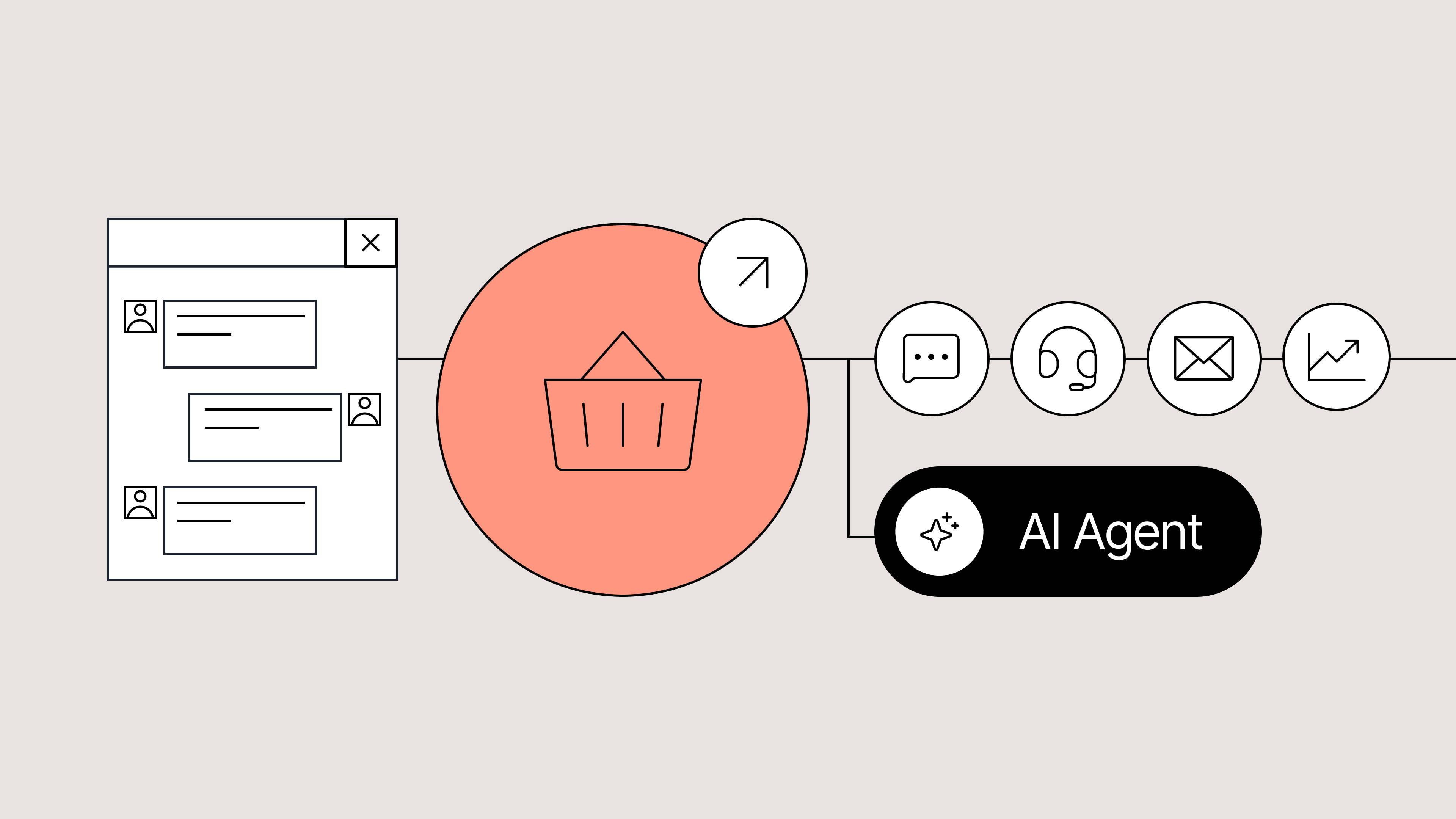
Conversational Commerce: A Complete Beginner's Guide
TL;DR:
- Conversational commerce replaces static support with real-time conversations. Instead of making customers wait or dig through FAQs, brands can respond instantly via chat, messaging apps, and voice assistants.
- The main types are live chat, AI assistants, messaging apps, and voice support. Each helps guide shoppers and answer questions instantly.
- It’s most effective during key moments like cart hesitation, post-purchase anxiety, and peak seasons. Proactive conversations reduce drop-offs and boost conversions.
- Start small and scale. Begin with repetitive questions or cart recovery, then layer in automation and AI as you grow.
While your competitors are still making customers wait days for email replies, the smartest brands are having conversations that close sales in real time.
Instead of forcing customers to search through FAQs or go through an automation loop, conversational commerce lets you have instant chats through live chat, messaging apps, and even AI assistants.
In this guide, we’ll explain conversational commerce, where it delivers the most value, and how to start using it to drive revenue and improve CX without overwhelming your team.
What is conversational commerce?
Conversational commerce means using real-time, two-way conversations as your storefront. Rather than bottling up questions in FAQ pages or forcing customers to wait for your support team to respond, you can instantly connect via:
- Chat
- AI agents
- Messaging apps
- Voice assistants
Maybe someone is on your product page and asks a question like, “Does this jacket run large?”. Through chat, they get an instant answer, increasing the chance of a sale. Or a shopper receives personalized recommendations via WhatsApp and checks out, all without leaving the app.
These channels allow you to meet customers where they already are, effortlessly. When paired with AI chatbots, you can deliver fast, accurate responses 24/7, even while your team is off the clock. That means better experiences for your customers and more sales captured for your brand.
Conversational commerce bridges the gap between shopping and support. It turns your support team (and AI tools) into revenue drivers by helping shoppers feel seen, heard, and ready to buy.
Types of conversational commerce
Conversational commerce means bringing your storefront into the flow of conversation, wherever that happens for your customers.
Here’s where those conversations typically happen:
- Live chat
- AI assistants
- Messaging apps
- Voice assistants
1. Live chat
This is a chat widget on your site, often in the bottom right corner, where shoppers can ask questions and receive immediate answers from a human agent or automation.
It’s a quick path to support or purchase, which one agent can manage multiple chats from simultaneously, boosting efficiency and keeping things personal.
2. AI assistants
These smart helpers use Natural Language Processing (NLP) to understand what shoppers mean beyond what they type. They guide customers through questions, offer product suggestions, handle FAQs, and can sometimes complete transactions right in the chat, even handling post‑purchase support like order status or returns.
Natural Language Processing (NLP): The processing of understanding and interpreting natural language using computers. NLP is used in tasks such as sentiment analysis, summarization, speech recognition, and more.
3. Messaging apps
Think WhatsApp, Facebook Messenger, WeChat, and SMS—the apps where customers already spend their time in their day-to-day. Instead of sending them to shop on your website, you bring the shopping to them. Answer their questions, provide recommendations, and win purchases in a channel they already trust.
4. Voice assistants
Voice assistance isn’t limited to smart speakers like Siri and Alexa anymore.
Now, AI voice support lets brands deliver natural conversations over the phone, without needing a massive contact center team. These AI voice agents can:
- Answer common questions using branded knowledge
- Route calls or escalate when needed
- Handle returns, exchanges, or order tracking
- Personalize support based on customer intent and past behavior
AI-powered voice support combines the human feel of a phone call with the speed and accuracy of automation. It's especially useful for high-ticket products, customers who prefer calling, or peak season overflow when your human team is maxed out.
The benefits of conversational commerce for ecommerce brands
Conversational commerce isn’t a CX buzzword. When done right, it directly impacts your bottom line.
Here’s how it pays off for ecommerce brands:
- Higher conversion rates
- Faster and more efficient support
- Bigger carts, fewer drop-offs
- Stronger customer relationships
1. Higher conversion rates
When customers can ask questions and get answers in real time, whether it's sizing info, shipping details, or help choosing between products, they’re far more likely to hit “buy.”
Success story: Clothing brand Tommy John generated $106K+ in sales in just two months through conversation-led upselling and cross-selling, with a 15% conversion rate.
2. Faster and more efficient support
Conversational commerce tools like AI agents help offload the repetitive support tasks, including answering questions like “Where’s my order?” or “What’s your return policy?”
With that time back, agents get time back to:
- Handle complex or sensitive customer issues
- Follow up with VIP customers
- Collaborate with marketing and sales teams to improve processes
- QA conversations to enhance human and AI agent performance
- Update knowledge docs used by AI tools for more accurate resolutions
Instead of getting buried in basic tickets, your team gets to do the work that really moves the needle for your customers and your business.
Related: Every successful marketing campaign starts with a customer question
3. Bigger carts, fewer drop-offs
The right nudge at the right moment, like a personalized recommendation from an AI shopping assistant, can turn a single item into a full cart. You can also recover more abandoned checkouts by re-engaging customers directly through chat or a messaging app.
Read more: You’re missing out on sales without an AI shopping assistant—here’s why
4. Stronger customer relationships
Conversational commerce lets you meet customers with a human (or human-like) touch. When your brand is helpful, fast, and easy to talk to, shoppers remember and return.
In the long run, that means better customer retention, higher lifetime value, and more organic growth through word of mouth.
When conversational commerce creates the biggest impact
Conversational commerce shines brightest when the stakes are high or when the moment is just right.
Here are the critical moments where a real-time conversation can make all the difference:
- When shoppers have items in their cart but are hesitating to check out
- Right after customers place an order, and anxiety starts to kick in
- During peak shopping seasons like Black Friday and Cyber Monday
- When customers are browsing complex products like skincare, makeup, or apparel
1. When shoppers have items in their cart but are hesitating to check out
A customer’s on your product page, they’ve added an item to their cart, but are hesitating. Maybe they’re unsure about sizing, shipping time, or which variation to choose. This is where a quick, helpful chat, automated or human, comes in and becomes the difference between bounce and conversion.
Pro tip: Use proactive chat prompts based on page behavior to start the conversation before the shopper leaves.
2. Right after customers place an order, and anxiety starts to kick in
After a customer hits “place order,” expect more questions to roll into your inbox. Where’s my order? How do I track it? What’s your return policy? Post-purchase excitement—and anxiety—is normal, and a smart AI agent helps you get ahead of these questions while putting customers at ease.
3. During peak shopping seasons like Black Friday and Cyber Monday
Black Friday. Holiday rush. Product drops. These are prime opportunities to boost revenue—but they also flood your support team. Conversational commerce tools help you scale without sacrificing quality, keeping shoppers happy and sales flowing.
4. When shoppers are browsing complex products like skincare, makeup, or apparel
If you sell skincare, supplements, tech, or anything that requires a bit of education, your customers likely need guidance before they commit. A personalized conversation helps them find the right fit and feel more confident in their purchase.
What to consider before you start
Conversational commerce sounds exciting, and it is. But before you dive in, it’s worth thinking through a few key factors to set your team (and your customers) up for success.
- Cost vs. ROI: Start small, scale smart
- Team resources: Who’s managing the conversations?
- Customer expectations: Meet them where they are
1. Cost vs. ROI: Start small, scale smart
You don’t need a full-blown chatbot army on Day 1. Start with your highest-impact touchpoints, like pre-sale FAQs or WISMO questions, and layer in automation over time. The goal is to generate clear ROI early, then expand once you see traction.
Here’s how to gradually implement automation into your CX process:
- Identify your top repetitive questions. Use your support data to pinpoint your most common tickets. For most brands, these are WISMOs, shipping concerns, and product-specific questions.
- Create macros for your most-asked questions. These macros will be used to answer the top recurring questions. For agents, this means no more copy-pasting the same responses.
- Build out self-service automation flows. Once you’re feeling more comfortable with automation, set up self-service flows to let customers resolve their own needs, like checking order status, starting a return, or finding their size.
- Automate your top channels. Don’t stop at email. Automate responses on live chat, Instagram DMs, and SMS too. Shoppers expect speed everywhere, not just on your site.
- Maintain impact, then introduce conversational AI. If your CSAT is still healthy after these changes, you can expand to using conversational AI for faster support and team efficiency.
The goal isn’t to automate everything, it’s to automate smartly so your team can spend time where it counts: high-touch sales, VIP support, and strategic growth.
2. Team resources: Who’s managing the conversations?
Do you have in-house agents ready to handle live chat? Or do you need automation to handle the bulk of it? Make sure your setup aligns with your team’s bandwidth.
Pro tip: Tools like Gorgias AI Agent and Shopping Assistant can handle the support and sales heavy lifting, making them perfect for lean CX teams.
3. Customer expectations: Meet them where they are
Your customers aren’t just on your website. They’re messaging on Instagram, browsing via mobile, or checking their texts. To deliver great conversational commerce, you’ll want to show up in the places your shoppers already use.
Pro tip: Don’t spread your efforts too thin. Start with the channel that aligns with your goals and customer behavior, live chat, SMS, or social DMs, and build from there.
How to get started with conversational ecommerce in 2 steps
Ready to make conversational commerce part of your CX strategy? You don’t need to overhaul your tech stack or hire a whole new team. With Gorgias, you can start fast, stay lean, and scale smart.
Here’s how:
1. Start with AI Agent for 24/7 support
Gorgias AI Agent is designed to take repetitive tickets off your team’s plate, from “Where’s my order?” to “How do I make a return?” It understands natural language, pulls in relevant customer data, and responds in seconds—all using your brand’s approved knowledge.
The result is faster responses, fewer tickets, and more time back for your team.
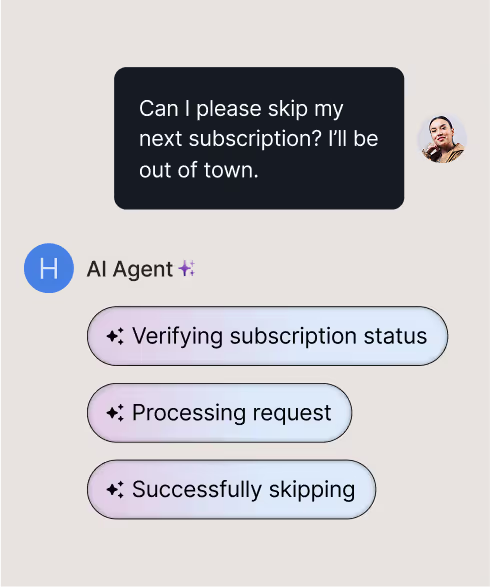
2. Add Shopping Assistant to drive revenue
While AI Agent, covers the support front, Shopping Assistant is your digital salesperson. It engages high-intent shoppers in real time, recommends the right products, and even upsells or cross-sells based on what the customer is browsing.
Whether it’s helping someone choose the perfect shade or nudging them to complete their cart, Shopping Assistant is designed to increase AOV and reduce abandonment.
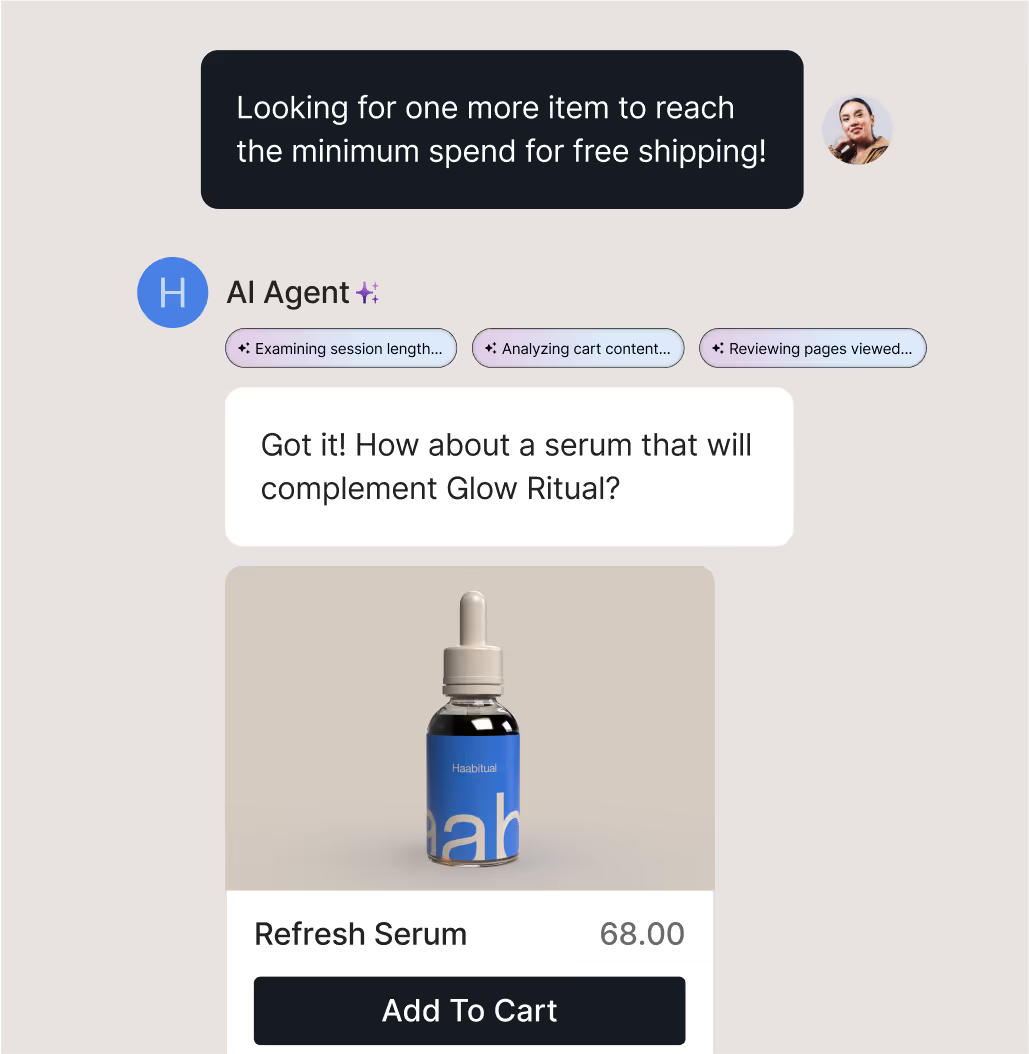
The future of ecommerce is conversational
Every time a shopper lands on your site, scrolls through Instagram, or replies to a shipping update, they’re opening the door to a conversation. The brands that show up quickly, helpfully, and with the right message, are the ones winning loyalty and revenue.
With AI Agent, you can automate accurate responses to common questions, giving your team time back without sacrificing customer experience. And with Shopping Assistant, you can turn those conversations into conversions, offering personalized recommendations, upsells, and discounts based on shopper intent.
You don’t need a massive team or months of setup to start. Just the right tools, and a strategy built for your customers.
Book a demo and learn how Gorgias helps you turn every conversation into an opportunity to grow.
{{lead-magnet-2}}
Further reading

How Do You Build a Support Sales Flywheel? Lessons from 4 Experts
TL;DR:
- Segment customers for personalized support. Use purchase history and behavior data to tailor every interaction, making conversations more relevant and higher-converting.
- Offer onboarding calls for complex products. TUSHY's "Poo-Rus" turned free install calls into a $15 paid service that dramatically boosts customer LTV and retention.
- Pick up the phone strategically. Use voice calls for abandoned carts, stuck tickets, and VIP follow-up.
- Give agents freedom to make judgment calls. Empower your team to bend policies and offer solutions that prioritize retention over rigid rules—confident agents drive more cross-sells.
- Train for helpful selling, not pushy pitches. Use roleplaying to teach agents how to spot buying signals and offer value naturally.
At Gorgias Connect LA 2025, CX leaders from Tommy John, TUSHY, Triple Whale, and Talent Pop shared how support teams solve problems and drive revenue.
This shift, known as the support sales flywheel, doesn’t involve massive overhauls or shiny new tools. Instead, it means doing the small things exceptionally well, like picking up the phone, empowering agents to make judgment calls, and adding a personal touch where others automate.
These brands have shown that when support teams focus on consistency, connection, and conversion, the results compound. Every thoughtful interaction spins the flywheel faster, boosting loyalty, LTV, and revenue.
Ahead, we’re breaking down the most actionable takeaways so your team can start building its own support-led growth engine.
Watch the full panel here:
5 tactics that power the support sales flywheel
From scrappy install calls to AI-powered training, these CX leaders aren’t only talking about driving revenue, they’re doing it. Here’s how they’re turning support into a sales flywheel, and the tactics your team can start testing today.
1. Personalization at scale starts with smart data
“Customer service done right is actually a great source of revenue.” That’s how Tamanna Bawa, Tech Partner Manager at Triple Whale, kicked off the conversation on how data can transform CX from reactive to revenue-driving.
She advises segmenting customers based on purchase history and behavior to deliver more personalized, higher-converting interactions.
In a market where margins are razor-thin and ad costs are high, Tamanna emphasized that “incremental gains from personalization are the difference between companies that are thriving and the ones that are just surviving.”
Steal this strategy
- Segment customers based on behavior and purchase history using your helpdesk, CRM, or analytics tool.
- Give agents access to this data so they can personalize every interaction.
- Use macros that adapt based on customer segments, like VIP status, product interest, or past issues.
- Focus on relevance over volume: one well-timed, tailored message converts better than a generic one.
2. The power of onboarding calls
What do you do when your hero product needs a cultural shift as much as it needs installation instructions? If you’re TUSHY, you send in your “Poop Gurus.”
Ren Fuller-Wasserman, Senior Director of CX at TUSHY, shared how her team launched a scrappy, free CX-led service that has now become a legendary video install program to help customers set up their bidets.
The real value wasn’t just tech support. As Ren put it, “It wasn’t about the actual install process, it was the encouragement they needed to change culture.” These calls sparked deeply personal moments (yes, even with cats and toddlers wandering in) and created the kind of emotional connection customers never forget.
Today, that service has evolved into a $15 paid add-on at checkout, and the customers who use it have significantly boost LTV and retention. It’s a masterclass in turning support moments into revenue through genuine human connection.
Steal this strategy
- Identify a product or feature your customers often hesitate to use, install, or fully understand.
- Offer free, low-lift onboarding calls via Zoom or Google Meet to guide them through setup or usage.
- Track LTV, CSAT, or repeat purchase rates for those who opt in.
- If it drives results, package it as a paid add-on at checkout or use it to surprise and delight key segments.
- Use simple tools like Calendly and Typeform to automate scheduling and reduce lift on your team.
3. When in doubt, pick up the phone
Phone support is back, and it’s becoming one of the most effective ways to turn conversations into conversions.
Ren from TUSHY swears by it. Her team uses customer phone numbers from abandoned carts to reach out directly. “You can send a hundred emails,” she said, “but a voicemail from a real person cuts through the noise.” Even if customers don’t answer, the fact that a brand called is memorable, and often enough to drive them back to checkout.
Max Wallace, the Director of CX Tommy John echoed the value of voice. His team recently implemented Gorgias Voice, using it to track conversion rates by agent. That visibility helps them identify what top performers are doing differently and replicate it across the team. “By the end of a tough call, customers often apologize for how they started. You can’t get that kind of de-escalation over email.”
In a world where inboxes are crowded and chat fatigue is real, a real voice builds real trust and real revenue.
Steal this strategy
- Start small: offer limited phone hours once your chat and email support are dialed in.
- Use phone strategically—for abandoned cart outreach, stuck tickets, or VIP follow-ups.
- Track call outcomes with tools like Gorgias Voice to see which agents are converting.
- Train agents to de-escalate and personalize through roleplaying or AI-based call simulations.
Pro Tip: Don’t rush into phone if your other channels aren’t dialed in. “Master email and chat first. Then, start with limited phone hours. Taste it before scaling it,” said Armani Taheri, the co-founder of TalentPop.
4. Trust your team to use their judgment
For Max at Tommy John, revenue-driving support starts with two things: deep product knowledge and the freedom to bend the rules.
“We have five different fabrics for men’s underwear alone,” Max shared. To help customers choose the right one, agents need firsthand experience. That’s why Tommy John sends new products directly to the support team, so they can offer real, personalized recommendations like “Try Second Skin instead of Cool Cotton.”
But product knowledge is only half the equation. The other half is empowering agents to make judgment calls. Tommy John’s “Best Pair Guarantee” allows customers to try a product and get a refund or replacement if it’s not the right fit.
Agents are trained to prioritize retention, offering replacements instead of refunds, recommending better-suited products, and using their own discretion to keep customers happy.
As Max put it, “We don’t have really strict policies… we want them to use their best judgment.” That confidence translates into smoother resolutions, more cross-sells, and customers who stick around.
Steal this strategy
- Send new or popular products to your CX team so they can speak from firsthand experience.
- Build simple product cheat sheets or comparison guides to help agents make tailored recommendations.
- Give agents clear guidelines—but also the freedom to make judgment calls when it comes to refunds, replacements, or policy exceptions.
- Let your team know it’s okay to “bend the rules” if it means keeping a customer happy.
- Track outcomes like retention and CSAT to show how empowered agents directly impact loyalty and LTV.
5. Training teams to sell without the push
How do you train outsourced agents to drive revenue, without sounding like a sales team? According to Armani Taheri of TalentPop, it starts with confidence and context.
“You have to tailor-fit the training approach to each brand,” he explained. That means grounding agents in product knowledge, tone of voice, and customer journey before they ever interact with a shopper.
One of the most effective tactics is roleplaying. Armani’s team uses both live roleplays and AI-powered chat simulations to prepare agents for real conversations, pre-sales, post-sales, and everything in between. Tools like Replit and Lovable help create lightweight, brand-specific training environments agents can practice in at their own pace.
The goal isn’t to turn CX reps into hard sellers. It’s to give them the confidence and consistency to recognize revenue opportunities, and act on them in a natural, helpful way.
Steal this strategy
- Start with the basics: make sure agents understand your product, tone of voice, and customer journey.
- Roleplay low-pressure scenarios, then layer in more complex ones.
- Try AI-powered training tools like Replit or Lovable to create brand-specific simulations agents can practice anytime.
- Emphasize helpfulness over selling: coach agents to spot buying signals and offer value, not push products.
- Review transcripts together to highlight great conversations and show how small shifts lead to better outcomes.
Tools to power your flywheel
Ready to turn your CX team into a revenue engine? Here are some of the tools mentioned by the panelists that help make it happen:
- Gorgias Voice: Track revenue by agent, spot top performers, and improve conversion rates across the team.
- Flip CX: Automate common phone interactions with AI-powered voice support.
- Kixie: Drop voicemails, integrate with Klaviyo and Shopify, and build smart call queues for abandoned cart outreach.
- Calendly + Typeform: Scrappy, low-lift tools for scheduling paid or free support calls that drive LTV.
Whether you're scaling phone support or experimenting with post-purchase outreach, the right tools make the flywheel spin faster.
Your CX team might be your best-kept sales secret
They’re on the front lines with your most engaged customers, answering questions, easing doubts, and uncovering what really drives purchases. With the right tools and training, they resolve tickets and help close the sale.
With tools like Gorgias Voice, it’s easier than ever to connect the dots between conversations and conversions.
Want to see how your CX team can help drive growth?
Book a demo to see how Gorgias Voice powers sales through support.
{{lead-magnet-1}}

Every Successful Marketing Campaign Starts with a Customer Question
TL;DR:
- Start with your CX team—they know what customers are asking. Their insights reveal what’s confusing, what’s converting, and what’s causing returns before marketing ever gets involved.
- Turn pre-sale questions into better messaging. Use common support queries to improve landing pages, product descriptions, and emails so customers feel confident enough to convert.
- Your best-performing products aren’t always the most hyped. Let real customer comments guide your messaging by identifying what people rave about in chats and reviews.
- Customer confusion and returns usually stem from messaging gaps. Fix product pages, policies, and descriptions to better reflect what people need to know upfront.
Your CX team talks to customers every day. They know what’s confusing, driving purchases, and causing returns, because they hear it firsthand.
But all too often, those insights stay siloed in support tickets and live chat transcripts instead of informing the campaigns that shape the customer journey.
This post is here to change that. We’re breaking down the most valuable questions marketing teams should be asking their CX counterparts. When marketing and CX work together, you get more relevant messaging, smarter product positioning, and campaigns that convert.
Whether you’re planning a big seasonal push or just want to improve product education, this is where to start.
{{lead-magnet-1}}
1. What do customers ask about before buying?
Your CX team knows what makes shoppers hesitate. They’re the ones fielding questions like: Does this come in a larger size? Is it final sale? Will it arrive in time?
Beyond being pre-sale inquiries, they’re signals. They reveal what your customers care about most, and where your messaging may be falling short. When marketing teams tune into this, they can proactively address objections in landing pages, product detail pages (PDPs), emails, and top-of-funnel content.

At luxury jewelry store Jaxxon, Director of Customer Experience Caela Castillo saw firsthand how important it is to address these questions early.
“Chat used to be a support tool for repetitive questions and problem-solving, but now AI Agent takes care of that for us,” she said. Once those friction points were handled upfront, the CX team could focus on more meaningful conversations, and conversions improved.
And when AI recommended the wrong products? Conversions dropped. It was a clear signal that relevance matters, especially before the sale.
Ask your CX team:
“What do customers most often need to know before they buy, and how can we answer that earlier in the journey?”
2. What product do customers rave about—and why?
Your best-selling product isn’t always your hero product. Sometimes, it’s that under-the-radar item that customers can’t stop talking about. The one that shows up again and again in reviews, chats, and post-purchase surveys.
The insight is gold for marketers. The key is to find out why people love it. Is it the fit? The feel? The results?
At online fashion brand, Princess Polly, Alexandria shared that her team expected Gen Z shoppers to lean on AI for recs, but what really influenced them was customer feedback. Reviews, not bots, built trust. That’s why campaigns built around real customer language and experiences often outperform the most polished product copy.
Shopping Assistant can turn those rave reviews into real-time action. It highlights top products using your Shopify product catalog to make personalized recommendations, proactively assists shoppers by using behavior signals, and even offers tailored discounts when they’re ready to convert. That means less guesswork, greater relevance, and an easier path to purchase.

Ask your CX team:
“Which product do customers rave about most, and what exactly are they saying?”
3. What product causes the most complaints?
When customers are frustrated, it’s easy to blame the product. But in many cases, the issue isn’t quality, it’s communication.
At Shinesty, a men’s underwear brand, Molly Kerrigan, Senior Director of Retention, observed that high return rates often stemmed from unmet customer expectations.
She noted the importance of maintaining clear and consistent communication as the company grows, “We get a lot of praise from our customers, and they talk highly of our CX team after 1:1 interactions. We can’t lose that as we scale.”
Molly notes that using Gorgias AI Agent enables Shinesty’s customers to receive quick answers, freeing her team's time for more complex or sensitive issues.
Similarly, Princess Polly saw that delivering a standout customer experience meant being fast, consistent, and helpful at every stage. After switching to Gorgias, their support performance improved dramatically:
- 80% decrease in resolution time
- 95% decrease in first response time
- 40% increase in efficiency
Before changing the product, try updating the messaging. Use insights from CX to rewrite descriptions, add size guides, include user-generated content, or even build a quick-fit quiz. Small tweaks help set clearer expectations and reduce unnecessary returns.
Ask your CX team:
“Which products are driving the most complaints, and what do customers wish they knew before buying?”
4. What confuses customers the most?
Confusion is a conversion killer. If a customer isn’t sure about how something works, what’s included, or whether it’s right for them, they’re more likely to bounce.
That’s why it pays to ask your CX team where customers get stuck. Is it a product feature that needs more context? A vague store policy? A missing detail on a bundle?
The good news is that most confusion is fixable. Start with the following steps:
- Simplify your product pages
- Add quick-hit FAQs to your emails
- Use plain language and real examples
If you’re using Shopping Assistant, you can go even further. It can detect when shoppers are hesitant and provides real-time nudges. Like an assistant who knows all your needs, Shopping Assistant automatically surfaces the questions customers are likely to ask when evaluating a product, so they’re equipped with the clarity they need to proceed to checkout.

TUSHY, a modern bidet brand, faced similar challenges. As bidets aren't mainstream in North America, shoppers often had concerns about product compatibility and installation. They’d ask questions like:
- Will a bidet fit my toilet?
- Is installation complicated?
- Which bidet is right for me?
Without immediate answers, many potential buyers would abandon their purchase. To address this, TUSHY implemented Shopping Assistant, providing instant support. Taking this approach resulted in an 81% higher chat conversion rate compared to human agents and a 13x return on investment.
“The Shopping Assistant has been a game-changer for our team, especially with the launch of our latest bidet models. Expanding our product catalog has given customers more choices than ever, which can overwhelm first-time buyers. Now, they’re increasingly looking to us for guidance on finding the right fit for their home and personal hygiene needs,” said Ren Fuller-Wasserman, Sr. Director of Customer Experience at TUSHY.
Ask your CX team:
“Where do customers get confused most often—and how can we clear that up sooner?”
5. Which products are frequently bought together?
Your CX team picks up on patterns that analytics sometimes miss. They hear which items customers ask about in the same chat, which products get added to carts together, and which pairings people reorder time and time again.
That intel is a goldmine for bundling and upselling. It helps you build smarter campaigns that feel relevant and drive real value.
Zoe Kahn, owner of Inevitable Agency and former VP of Retention and CX at Audien Hearing, emphasizes the importance of using AI to enhance customer interactions.
“A lot of that revenue was potentially missed revenue because these were customers sitting on the site, asking questions about the products, and wanting an answer now so they could purchase…Now, AI can answer those questions immediately and convert those customers.”
With Shopping Assistant, you can act on these insights in real time. It will surface personalized product pairings, bundle suggestions, or accessories based on customer behavior. All before they hit the checkout page.

6. Which products lead to the most returns, and why?
Returns cut into your margins and chip away at trust. Most of the time, they’re not caused by poor-quality products. They happen because expectations weren’t met.
Your CX team already knows which items come back the most and why. Maybe the color doesn’t match the photos. Perhaps the fit runs small, or the product description left out a crucial detail.
Instead of pushing the product harder, reframe how you present it. Add real customer photos. Include fit notes or a sizing chart. Call out anything that might surprise the customer post-purchase. A little clarity upfront goes a long way in reducing returns and boosting retention.
At Pepper, an intimates brand specializing in bras for small-chested bodies, they recognized the importance of pre-sale education. When customers have sizing questions, their AI Agent, Penelope, can provide immediate assistance.
“Penelope takes the information we give her and responds better than a Macro. She tailors it so that it sounds like a natural conversation between two people,” said Gabrielle McWhirter, CX Operations Lead at Pepper.
By proactively providing instant support, Pepper improved customer satisfaction and saw an 18% uplift in average order value.
Ask your CX team:
“Which products get returned the most—and what could we do upfront to change that?”
CX + marketing = smarter campaigns, better results
Before you launch your next campaign, start with a quick sync with your CX lead. They already know what your customers need to hear. You just have to ask.
From fixing messaging gaps to surfacing the right products at the right time, these insights help you connect with customers in personal, timely, and relevant ways.
Tools like Shopping Assistant make it easier than ever to act on this data in real time. You can turn CX knowledge into dynamic recommendations, personalized nudges, and smarter discounts.
Ready to see how you can improve your online shopping experience? Book a demo to see how Gorgias Shopping Assistant engages customers in real-time.

How to Use CX Data to Improve Marketing, Messaging & Conversions
TL;DR:
- Your support inbox is full of marketing gold. CX insights can sharpen messaging and inspire high-impact campaigns.
- Ticket data unlocks smarter segmentation. Use support interactions to build more relevant, behavior-based audiences.
- Chat campaigns work better with CX insights. Tackle objections in real time and lift conversions with proactive messages.
- Use objection data to reduce drop-offs. Identify common blockers and address them in product pages, ads, and chat prompts.
- Help Center stats guide better content. Turn top-searched questions into FAQs, landing pages, and ad copy.
Today’s best marketing starts with your customers.
According to Forrester’s 2024 research, “Customer-obsessed organizations reported 41% faster revenue growth, 49% faster profit growth, and 51% better customer retention than those at non-customer-obsessed organizations.”
Support teams interact with hundreds or thousands of customers every week, collecting valuable insights in the process. This voice of the customer (VOC) data is a goldmine for marketers, but it too often stays siloed among CX teams.
Ahead, we’ll break down how ecommerce brands can tap into CX insights to drive better marketing.
5 ways to use CX data to improve marketing
CX can play a crucial role in driving growth, but many brands aren’t leveraging it for marketing insights yet.
When connected to marketing, CX becomes a proactive engine that fuels better segmentation, sharper messaging, smarter campaigns, and more personalized content.
Support functions collect objections, complaints, compliments, and pre-purchase questions. When you capture and apply those insights, your marketing can target the precise roadblocks—and key sales differentiators—customers care about.
Here’s how to turn CX insights into a high-impact marketing strategy, with real examples from brands using Gorgias.
- Leverage ticket insights to improve messaging
- Segment customers based on support interactions
- Launch more targeted chat campaigns
- Reduce drop-offs and abandoned carts
- Monitor Help Center and Dashboard stats to craft smarter content
1) Leverage ticket insights to improve messaging
When you want to sharpen your brand messaging, there’s no better place to look than your support inbox. Your support inbox is a rich resource full of information specific to your brand and your customers.
Tools like Gorgias Ticket Insights help surface recurring themes, top questions, and friction points across all conversations. By analyzing these patterns, marketers can identify the exact words customers use to describe problems, questions, or product feedback and then reflect that language across ads, landing pages, and emails.
How to implement
Spikes in tickets around specific topics (sizing, shipping timelines, and materials, for example) are insights marketers can use to update and improve corresponding content.
This can increase confidence and conversion on key pages.
By incorporating the same terminology and phrasing customers use in support conversations, brands can also increase resonance across ads, emails, and social media. Messaging that mirrors the customer’s language builds trust and helps audiences feel understood.
Ask your CX team 💬 What product issues or themes have emerged this quarter?

For example, cordless heating cushion brand Stoov® used Ticket Fields in Gorgias to understand and resolve a ticket spike. By figuring out that some customers were dissatisfied with the battery life of its core product offering, the team was able to add an optional upsell. For €20, shoppers now have the option to purchase a larger battery.
The results were meaningful: the brand saw 50% of customers opt for this battery, resulting in a 10% increase in average order value (AOV). And while the team saw a significant increase in revenue, they saw no increase in support ticket volume.
2) Segment customers based on support interactions
Most marketers rely on transactional data—like past purchases or time since last order—to build audience segments. But support data reveals a whole new layer of context: behavior, concerns, sentiment, and urgency.
Tools like Gorgias’s Ticket Insights and Ticket Fields allow CX teams to customize different properties attached to tickets. Agents can fill these out to capture data more accurately.
Here’s how these types of tools work: tickets come with a mandatory field for return reasons, product feedback, contact reason, etc. Before the agent closes the ticket, they use a dropdown menu to fill out the ticket field.
How to implement
Studying support interactions helps answer key questions around why customers are getting in touch. This data can provide marketing teams with a way to build smarter segments for campaigns or personalized journeys.
For example, if one product is getting a large amount of inquiries, marketing teams could segment customers interested in those products and launch pre-sales education campaigns.
Fashion brand Psycho Bunny switched from Zendesk to Gorgias to improve access to reporting tools that surfaced customer patterns and support trends.
“By cross-referencing our Gorgias data with insights around basket size, product performance, and store performance, we can inform broader business decisions. For example, we can see if a certain store location generated more tickets or how many incoming queries are about a certain product,” says Jean-Aymeri de Magistris, VP IT, Data & Analytics, and PMO at Psycho Bunny.
By integrating insights like these with marketing workflows, teams can build more relevant segments that improve retention and engagement.
Ask your CX team 💬 Which customer segments are most likely to churn or repurchase?
3) Launch more targeted chat campaigns
Chat campaigns are proactive messages that trigger based on real-time behavior and context. You can use CX trends to design campaigns that directly address common objections, answer FAQs, or deliver tailored offers.
How to implement
Start by reviewing your most common pre-purchase questions with your CX team. Then, create chat prompts that address those concerns exactly where they arise. For example, a sizing guide prompt on product pages or a shipping FAQ in the cart.
Make sure your message feels helpful and not overly salesy. Conversational AI assistants like AI Agent can also tailor responses in real-time, helping customers get what they need without leaving the page.

Pepper, a size-inclusive bra brand, put this into practice by combining their AI Agent (named Penelope) with targeted chat campaigns to guide shoppers through one of their most common friction points: sizing. Thanks to insights from their support team, Pepper created messaging that helped customers find the right fit instantly. The result was an 18% uplift in average order value.
“With AI Agent, we’re not just putting information in our customers’ hands; we’re putting bras in their hands. With Penelope on board, we’re turning customer support from a cost center to a revenue generator,” says Gabrielle McWhirter, CX Operations Lead at Pepper.
Ask your CX team 💬 How are customers reacting to recent promotions or launches?
4) Reduce drop-offs and abandoned carts
When shoppers hesitate at checkout, it’s often because they don’t have the information they need.
Tapping into support conversations allows CX teams to identify common objections. They can then share those insights with marketing to refine product messaging, improve product pages, ads, and marketing campaigns.
How to implement
Use customer service data to identify the top three objections customers have before converting. These might be concerns about sizing, compatibility, delivery time, or product setup. Then, pair that knowledge with a proactive AI sales tool like Shopping Assistant to offer timely answers that move shoppers closer to purchase.
For example, TUSHY, a modern bidet company, found that many prospective customers were hesitant because they weren’t sure how difficult the installation would be. By using a real-time shopping assistant to address these concerns directly on-site, TUSHY was able to guide shoppers past uncertainty.

Ask your CX team 💬 What are the top three reasons customers contact us before they buy?
5) Monitor Help Center and Dashboard stats to craft smarter content
If you want to know what content your customers actually need, your Help Center holds the answers. Real customer questions are found right in Help Center search queries and article analytics.
By tracking which articles are most viewed, most searched, and most frequently updated, marketers can spot common knowledge gaps and fill them with high-value content.
How to implement
Start by reviewing your Help Center Statistics to see which articles are performing well, which ones are underutilized, and what terms customers are searching for.
If an article about “returns policy” is getting a spike in views, that’s your cue to simplify the policy or preempt questions with a dedicated email campaign. Marketing teams could also use this insight to build FAQ-rich landing pages, preempt questions in email flows, or even turn top-performing help content into organic blog posts or performance ad copy.
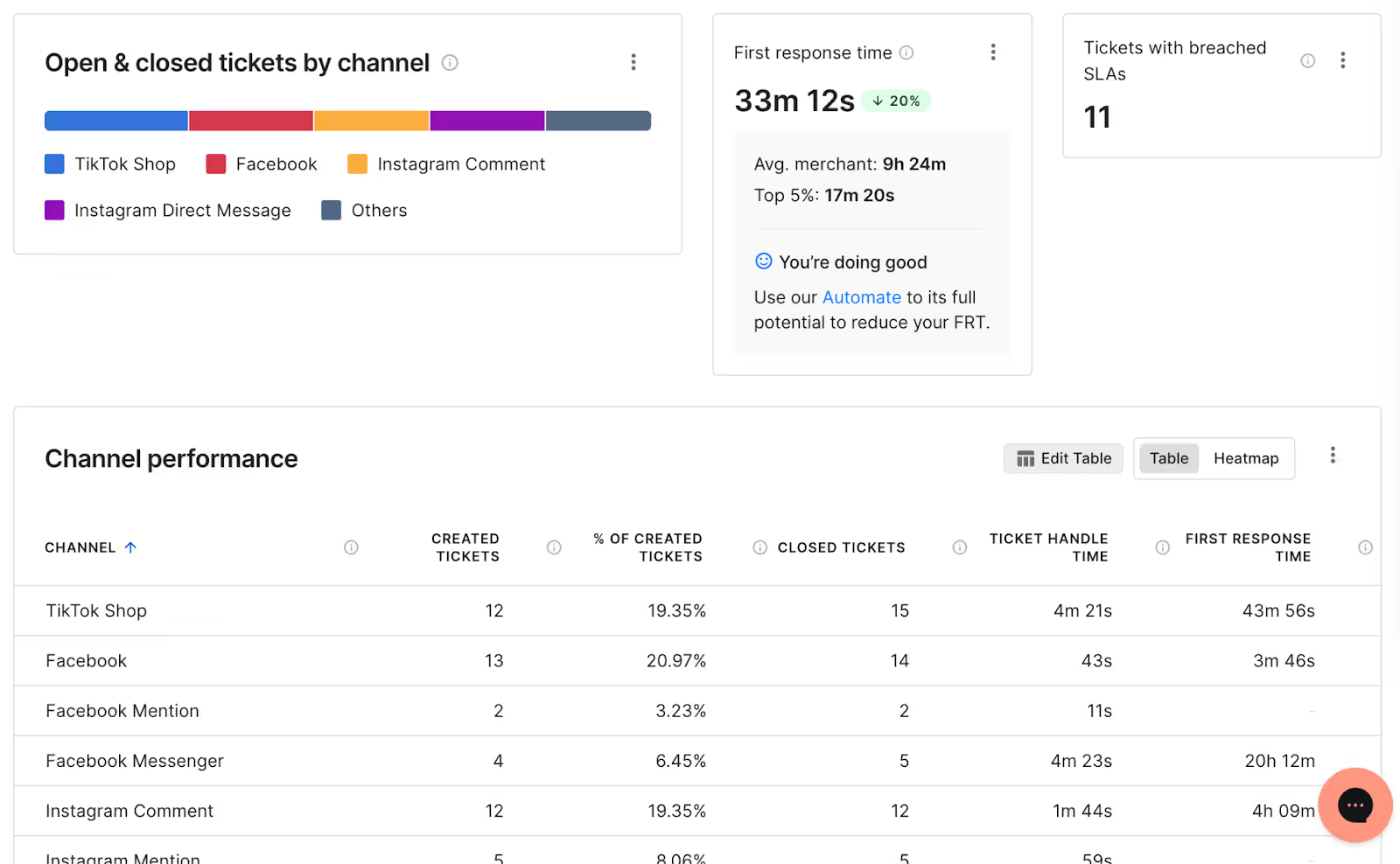
You can also use Gorgias's Dashboard to spot emerging trends across all your channels. This custom reporting feature lets you choose from various charts that reveal high-level patterns—like the most common contact reasons or sudden spikes in ticket volume—giving marketers early insight into shifting customer sentiment and trending topics across social platforms.
Ask your CX team 💬 Which articles in our Help Center are most searched right now?
Find alignment between CX and marketing teams
When support and marketing teams collaborate, you unlock a cycle of continuous improvement. CX teams surface the insights, marketing turns them into strategy, and both sides drive measurable results.
Here’s how to make it work:
- Set up recurring syncs between CX and marketing teams to review insights from customer service reports.
- Involve support in campaign planning to consider what customer objections might come up.
- Encourage CX to tag tickets based on themes or behavior that marketing can act on.
Unlock revenue by listening to your customers
We need to reframe CX as a proactive function that drives revenue.
Support teams already have the answers marketers are searching for. You just need the tools to tap into them. Gorgias makes that easy, with flexible reporting features, powerful AI, automated tagging, and integrations that bridge the gap between CX and marketing.
Want to connect your support data to better marketing?
Explore Gorgias’s analytics tools or book a demo to speak to a product expert about how to integrate your support strategy with marketing.
{{lead-magnet-1}}

The Hidden Cost of Not Adopting AI in Ecommerce
TL;DR:
- Ecommerce brands not using AI are falling behind, as 77.2% already use it daily to boost efficiency and revenue.
- AI saves time and cuts costs, like Trove Brands saving $23K/month and reducing cancellations by 70%.
- Customers want speed and privacy—AI provides fast, judgment-free answers in sensitive categories.
- AI empowers support teams by handling routine tasks so agents can focus on high-value interactions.
Doing nothing when there’s rapid change happening in an industry is risky business.
Right now, according to our latest report, 2025 Ecommerce Trends, 77.2% of ecommerce professionals are already using AI in their day-to-day work. What happens if you’re part of the 22.8% that isn’t?
Inaction is action—one that’s a quiet drain on revenue, resources, and reputation.
Every minute spent on manual work is a minute your competitors are focusing on higher-value customer interactions, improving CX, testing offers, and scaling campaigns.
And the cost of falling behind is compounding fast. Here’s what you’re losing when you pass on AI.
Time lost = money lost
As support volume grows, so does the cost of inefficiency.
Nearly 80% of CX professionals say AI saves them time. In fact, 83.9% of support leaders using AI in Gorgias say it has made their teams more efficient.
Trove Brands experienced this firsthand:
- They reduced missed cancellations by 70%
- And saved $23,000/month in labor costs by automating repetitive support tasks
If AI can handle 70% of your support tickets, your team finally has the time—and headspace—to focus on the 30% that actually builds trust, drives repeat revenue, and improves the customer experience.
Trust when customers need it most
Hot take: AI isn’t impersonal. Not using it is.
In 2024, nearly one-third of CX leaders worried AI would make interactions feel less human. A year later, that number dropped by half.
Why? Brands started to see that AI wasn’t hurting the customer experience, it was removing friction from it.
For sensitive or personal products—think wellness supplements, intimate gifts, or anything a shopper might feel awkward asking about—AI creates space for honesty without judgment. And that can change the outcome entirely.
“Too often, a great interaction is diminished when a customer feels reduced to just another transaction,” said Ren Fuller-Wasserman, Senior Director of Customer Experience at TUSHY. “With AI, we let the tech handle the selling—unabashedly, if needed—so our future customers can ask anything, even the questions they might be too shy to bring up with a human. In the end, everyone wins.”
It’s a powerful point, especially for brands where discretion matters. AI removes that barrier.
You're losing trust if your support experience still makes customers hesitate. For many, that means being able to get an answer without needing to explain themselves first.
Revenue hiding behind unanswered questions
Every unanswered pre-sale question or missed upsell is revenue slipping through your fingers.
Product recommendations alone have the potential to increase revenue by up to 300%, boost conversion rates by 150%, and drive 50% higher AOV. But those results don’t come from hoping customers find what they need. They come from proactively guiding them.
That’s where AI comes in.
With Gorgias AI Agent and automation features, for example, Kirby Allison
- Increased conversions by 23%
- Grew sales from support by 46% in just two months
“Our favorite features are definitely Flows and Article Recommendations. They drive so much automation for us. Shoppers get answers to their questions by themselves—what’s the right size hanger, where is my order, what shoe polish would you recommend, etc,” said Addison Debter, Head of Customer Service.

Flows let Kirby Allison surface up to six commonly asked questions directly in the chat widget. When clicked, each one opens a relevant help article—no agent needed.

Auto responses also allowed the team to handle common inquiries like sizing, shipping, and order tracking before a human ever steps in.

If your support team isn’t set up to handle pre-sale conversations at scale, the cost isn’t just in time. It’s in all the revenue you never realize you’re missing.
A CX team stretched thin
It might sound counterintuitive, but AI gives your team more space to be human.
The myth that AI replaces agents is still floating around in some circles, but the reality inside fast-growing ecommerce teams looks different.
In fact, AI frees up time for your team to focus on what they do best: solving complex problems, building relationships, and creating moments that actually drive loyalty.
SuitShop is a perfect example of this in action. When the team adopted AI Agent, they paired automation with intentional escalation:
“We’re helping customers feel confident during some of the most important moments in their lives—weddings, proms, job interviews, and everything in between. Naturally, my biggest concern with introducing AI was: ‘Will customers feel like they’re getting the same level of care from AI?’ But learning that AI Agent would pull knowledge from our Help Center articles and Macros, which are already written in our brand voice, made me feel more confident,” said Katy Eriks, Director of Customer Experience.
AI was able to handle common pre-sale questions like shipping timelines and product availability, while human agents stepped in for customizations, wedding-specific questions, and tailored styling support.
The goal wasn’t to remove the human element. It was to give their agents the time and context to show up more meaningfully.
The longer you wait, the harder it is to catch up
In just one year, AI adoption among Gorgias users jumped from 69.2% in 2024 to 77.2% in 2025.
Excitement is rising, too: 55.3% of ecommerce professionals now rate their interest in AI as 8–10 out of 10, up from 45.6% the year prior.
AI is no longer in its experimental phase. It’s the standard, baked into everyday workflows across ecommerce.
If you’re still on the sidelines, 2026 is going to feel like a catch-up game.
The good news? You don’t have to overhaul everything to get started.
So while we’re on the topic of speed, let’s walk through how to start implementing AI for your brand.
How to get started with AI
You don’t need to automate everything on day one. The best CX teams start small, pick the right entry points, and give AI the same level of care you’d give a new team member. Here’s how to roll out AI in a way that actually works:
1. Vet your options thoughtfully
When searching for a new AI tool to help you manage CX, look for one that:
- Offers strong tone-of-voice control so your AI doesn’t sound like a chatbot from 2012
- Delivers consistently accurate responses, even as inputs and workflows evolve
- Provides real post-sale support to help your team troubleshoot, train, and scale usage
Price matters, but it shouldn’t be your only filter.
Also, AI should make your team feel more capable. If it feels like a bolt-on or requires constant developer help, it’s going to create friction, not solve it.
2. Make someone own it
The most successful AI implementations all have one thing in common: someone owns it.
“One of our CX Managers spent 30–40 hours a week building and refining AI. That ownership was critical,” said Sarah Azzaoui, VP of Customer Experience at Clove, when she was explaining how her team first got started with AI.
What many people don’t realize is that AI isn’t going to be perfect out of the gate. AI takes real time and intention to build out. Assigning a clear point person—or better, a small squad—ensures someone is tracking performance, making optimizations, and flagging edge cases.
3. Involve your CX team from the start
No one knows your customer conversations better than your support team. They see the full range of questions, tone, friction points, and emotional nuance every day.
Bringing them into the AI rollout early helps you:
- Identify which questions are repetitive and low-stakes
- Flag which issues should always be handled by a human
- Set realistic expectations across the org about what AI should handle vs. what it could handle
This step also builds trust. If your agents feel like AI is something being done with them instead of to them, adoption is smoother and the outcomes are better.
4. Start small with the right topics
One of the biggest mistakes brands make with AI is trying to do too much, too soon. AI rollout should feel like a phased launch, not a switch flip.
Start in a test environment if your platform allows for it. Roll out automation in stages—by topic, channel, or ticket type—and QA every step of the way.
We suggest beginning with high-volume, low-complexity tickets like:
- “Where’s my order?”
- Subscription pauses or cancellations
- Returns and exchanges
- Store policies and FAQs
Platforms like Gorgias offer tools like Auto QA that track whether AI responses hit the right tone, offer accurate answers, and resolve issues effectively. Use those tools to catch gaps early and monitor performance over time.
That slow, deliberate rollout pays off in performance. At Psycho Bunny, AI Agent now automates 30% of customer tickets, with custom messaging that reflects their brand tone and processes.
Once you’re ready to scale, you’ll feel more confident that the simple queries are handled correctly while you start to train the AI on more nuanced questions.
For example, Gorgias’s Guidance feature gives AI access to non-public SOPs so it knows how to respond or when to escalate.
“The Guidance feature is so important,” said Tosha Moyer, Senior Customer Experience Manager at Psycho Bunny. “We have a lot of processes that we definitely don’t want described in a customer-facing article, but we want AI Agent to be able to access that information and manage tickets accordingly.”
5. Prep your knowledge base
Even the best AI platform can’t succeed without solid inputs.
Before you roll out, take a hard look at your help docs and macros:
- Are they accurate?
- Are they clear and consistent in tone?
- Are they tagged so AI can understand when to use them?
Think of this step as training your AI. The stronger your internal content library, the more helpful and brand-aligned your AI will be across every channel.
6. Communicate with customers
Whether you disclose AI usage is up to you, but be intentional.
Some brands choose anonymity for a more seamless experience. Others find that transparency builds trust, especially when something goes wrong.
What matters most is that your approach aligns with your brand tone and customer expectations—and that clear escalation paths are in place if a conversation needs a human.
Research shows that 85% of consumers want companies to share their AI assurance practices before rolling out AI-powered experiences. Customers are open to AI. But they expect clarity when it counts.
7. Scale the program over time
Once you’ve built the foundation, scaling AI across your CX org becomes a lot easier.
“We started with cancellations. Now we’re rolling out warranty claims, retention campaigns, and more,” said the team at Trove Brands.
After proving value with one or two ticket types, look for opportunities to expand:
- Pre-purchase product recommendations
- Exit-intent offers via chat
- Predictive personalization
- Multichannel automation across email, SMS, and live chat
The goal is to implement smarter automation that makes your team more effective and your customers more supported.
The future is human + AI
The best CX teams aren’t choosing between AI and human agents. They’re choosing both and building stronger systems because of it.
“It’s not human agents vs. AI,” said the team at Clove. “Our team helped shape the AI strategy—and that changed everything.”
But ignoring AI? That comes at a cost. And it’s not just inefficiency. It’s:
- Missed sales from unanswered questions
- Slower support that erodes customer trust
- Burnt-out teams stuck in reactive mode
- Lower CSAT from inconsistent experiences
- And eventually, falling behind as the rest of the market moves forward
It’s time to build it into your workflows. Not just as a helper, but as a core part of your team.
Start using Gorgias AI Agent to reduce ticket load, recapture revenue, and deliver the kind of support that actually feels personal.
{{lead-magnet-1}}

Stop Resolving These 7 Tickets Manually (Use AI Agent Actions Instead)
TL;DR:
- Actions are tasks automatically performed by AI Agent for customers. From address changes and subscription pauses to order cancellations, Actions can fulfill requests for your customers, even when your human agents are offline.
- Actions connect directly to your ecommerce apps. Currently, Actions have native integrations with Shopify, ShipMonk, ShipHero, ShipStation, Stay AI, Recharge, Loop, Subscriptions by Loop, Skio, Seal Subscriptions, and Wonderment.
- Use pre-built Actions or build your own. There are 12 Action templates available, or you can build Actions using custom HTTP requests.
- Watch out for setup snags. Conflicting Guidance, multiple matching Actions, older orders, or broken logic can block an Action from executing.
Automated responses don’t actually resolve anything. In reality, they increase customer wait time.
What a customer really wants is immediate resolution, whether they’re looking to cancel an order, change a shipping address, or pause a subscription.
So, how do you go beyond automated text responses? AI Agent Actions.
Below, we’ll go over the 7 most common customer service requests you can resolve with AI Agent Actions, so your team gets time back to strengthen customer relationships, increase revenue, and improve your CX strategy.
{{lead-magnet-1}}
What are AI Agent Actions?
AI Agent Actions are tasks AI Agent can complete for your customers, such as canceling an order or updating a shipping address.
Instead of handing it off to a human agent, AI Agent resolves the ticket by connecting to your ecommerce apps and performing the action on its own.
You get maximum control over when and how Actions are executed. Before performing the Action, AI Agent asks customers for confirmation, respecting your processes and maintaining a high level of customer service. Once an Action has been taken, you can even share feedback with your AI Agent to reinforce its behavior or finetune it further.

Pro Tip: Unlike Guidance, which tells AI Agent how to respond in a conversation, Actions determine what happens. It’s the difference between saying “I’ll refund your order” and doing it.
Related: How AI Agent works & gathers data
Top 7 customer requests you should be automating with AI Agent Actions
Ready to resolve requests in seconds? Activate these pre-built Actions in Gorgias to keep your team efficient and your customers happy.

1. Customer wants to update their shipping address
Action to use: Update shipping address
Supported apps: Shopify, ShipMonk, ShipHero, ShipStation
Incorrect shipping addresses lead to costly re-shipments, delays, and even refunds. Catch errors early to keep customers satisfied and excited about their order.

Why do you need this Action?
The reality is your agents aren’t available 24/7. Unless you hire a team to cover night and weekend shifts (which is unlikely), requests will be missed. AI Agent fills in that gap, handling time-sensitive issues when your team is off the clock. Missing them isn’t just about poor customer experience—it can also lead to extra costs, like reshipping orders.
2. Customer wants to cancel an order
Action to use: Cancel order
Supported apps: Shopify, ShipMonk, ShipHero, ShipStation
Perhaps a customer ordered the wrong item, chose the wrong size, used the wrong card, or simply changed their mind. Allow them to quickly cancel their order and receive a refund in one go.

“Actions responds to tickets within about 30 seconds and is available 24/7. Regardless of when a customer places their order, the likelihood of quickly catching and canceling the order has increased by 70% since we started using Actions. It’s an exceptional result."
—Jon Clare, VP of Customer Service at Trove Brands
3. Customer wants to replace/remove an item in their order
Actions to use:
- Replace item, or
- Remove item
Supported app: Shopify
It happens—shoppers order the wrong size or color and want to change their order immediately. Regardless of the reason, make their new decision easy to implement. Quick, accessible order updates prevent returns, lost revenue, and, most importantly, customer disappointment.
Here’s what the replace order item setup looks like in Gorgias:

Pro Tip: If you have unique workflows, you can create advanced, multi-step Actions and connect to your tools beyond our default integrations. This option requires some tech know-how (like custom HTTP requests), so feel free to bring in your developers for assistance.
4. Customer wants to skip or pause a shipment
Actions to use:
- Skip next subscription shipment, or
- Pause subscription
Supported apps: Stay AI, Recharge, Subscriptions by Loop, Skio, Seal Subscriptions
Subscriptions shouldn’t be all or nothing. Let customers skip a shipment or pause their subscription, so they can come back when they’re ready. Giving them full control lets them manage their subscription on their own terms, reducing churn rate in the process.
Here’s how AI Agent handles a skip shipment request:

5. Customer lost or damaged their order in transit
Action to use: Reship order for free
Supported apps: Shopify, ShipMonk
No customer expects a lost or damaged order. Let customers know that you have their backs by reshipping a new order free of charge. Fast resolutions during unexpected events demonstrate your commitment to customer satisfaction.
“An instant response builds confidence. We live in a world with short attention spans, so customers appreciate how quickly we can respond to their inquiries. Customers aren’t worrying unnecessarily for longer than they have to for an address change or order cancellation.”
—Mia Chapa, Sr. Director of Customer Experience at Glamnetic
6. Customer wants to know their return shipping status
Action to use: Send return shipping status
Supported app: Loop
Customers want to know that their return package is on its way to you, so they can redeem their refund. Easily send them a shipment tracking link to give them that peace of mind.
7. Customer wants to know about order status
Action to use: Get order info
Supported apps: Shopify, ShipHero, ShipMonk, ShipStation, ShipBob, Wonderment
Based on Gorgias data, order status ranks among customers' top 10 questions for support teams. Reassure your customers with quick updates on their orders, including product details, shipping progress, expected delivery date, and other helpful information.
What to know before turning on Actions
Here are a few helpful setup tips to make sure Actions run without a hitch:
- Guidance can override Actions. If conflicting Guidance exists, it may prevent an Action from triggering, even when all conditions are met. Review your Guidance to avoid overlaps, or write your logic into the Action description instead.
- Any Action that changes data requires shopper confirmation. Actions like canceling orders, updating addresses, or canceling subscriptions mean AI Agent will always ask the shopper to confirm before making a change.
- Currently, only one Action can run per ticket. If multiple Actions qualify, none will run, and the ticket will be handed off. Use conditions carefully to ensure only one Action matches per use case.
- AI Agent can only access the shopper’s last 10 orders. If the customer references an older order, the Action won’t trigger and the ticket will be handed over for manual handling.
AI Agent Actions speak louder than words
If you want…
- Fewer repetitive tickets
- Faster customer support
- Happier customers who get what they need instantly
- More time for your team to strategize
- Lower costs and higher efficiency
AI Agent Actions can get you there.
You’ve now seen how Actions can resolve tickets in a snap—no unnecessary handoffs, canned responses, or long response times.
Book a demo to see AI Agent Actions work in real time and start automating what you shouldn’t be doing manually anymore.
{{lead-magnet-2}}

How to Write Guidance with the “When, If, Then” Framework
TL;DR:
- AI Agent is only as good as the instructions you give it. Clear Guidance enables it to perform like your best support teammate.
- The “When, If, Then” framework makes writing Guidance easy and repeatable. Start with the scenario (when), define the conditions (if), and list specific actions (then) to create structured Guidance.
- Use Guidance to handle frequently asked questions, like returns, cancellations, or discount code inquiries, so your team can focus on more complex issues.
- If your Guidance isn’t working, formatting or logic gaps might be to blame. Check for missing conditions, unsupported tasks, or confusing formatting.
AI Agent is built to deliver fast, accurate support at scale, but like any teammate, it performs best when given clear and specific instructions.
That’s where Guidance comes in. Writing structured prompts that tell your AI Agent exactly what to do in a given scenario helps reduce escalations, speed up resolutions, and create a more consistent customer experience.
One simple, repeatable way to do that is with the “When, If, Then” framework.
In this post, we’ll show you how it works, using examples from our Gorgias Academy course, Improve AI Agent with Better Guidance.
You’ll learn how to write Guidance that results in:
- Fewer escalations
- Faster resolutions
- Smarter, more consistent AI behavior
Let’s break it down.
{{lead-magnet-1}}
What is Guidance?
Guidance is how you tell your AI Agent what to do. It’s a set of instructions that outlines how your AI Agent should respond in specific situations.
When Guidance is available, your AI Agent follows it first, even before checking your Help Center or website content.
That means if your Guidance is missing, unclear, or incomplete, your AI Agent might escalate the ticket, or worse, give a confusing or unhelpful response. Here’s an example:
Let’s say a customer wants to return an item. A human agent would send them a link to the return portal and explain the steps. But without that instruction in Guidance, your AI Agent might skip straight to escalation, turning a simple request into unnecessary work for your team.
That’s why clear, step-by-step Guidance is key to help your AI Agent respond the way your best support agent would.

Learn more: Create Guidance to give AI Agent custom instructions
Introducing the “When, If, Then” framework
Sometimes it’s hard to know where to start when writing Guidance. The “When, If, Then” framework gives you a simple, repeatable structure to follow, so there’s no need to guess.
Taking this approach mirrors how AI Agent processes information behind the scenes. When you write clear Guidance, your AI Agent can follow it step by step, just like a support teammate would.
Let’s walk through the three parts of the framework.
WHEN: Set the scenario
Start by identifying the situation your Guidance applies to. This is the trigger or scenario. Use it as the title of your Guidance so it’s easy to find later.
Example:
- WHEN a shopper asks to return an order
- WHEN a customer wants to cancel their subscription
Keep it simple and action-oriented. You’re setting the stage for what comes next.

IF: Add conditions
Once you’ve defined the scenario, add any conditions that determine what should happen. “If” statements help your AI Agent understand what to do based on specific details, like timing, order history, or customer tags.
Example:
- IF the order was placed less than or equal to 15 days ago
- IF the customer has a VIP tag in Shopify
Use as many “if” conditions as needed to guide different outcomes. Just make sure you cover all the possibilities so your AI Agent doesn’t get stuck.
THEN: Define the actions
This is where you tell your AI Agent exactly what to do. Be specific and use bullet points or numbered steps to keep things clear.
Example:
- Tell the shopper they’re eligible for a return
- Send them a link to the return portal
- Let them know they’ll receive a prepaid label once the form is submitted
The more clearly you outline the steps, the more consistently your AI Agent will perform.
The framework keeps your Guidance simple, structured, and easy to understand—for both your team and your AI Agent. When your AI Agent knows exactly what to do, it can deliver fast, accurate, and helpful responses that keep customers happy.
Put it all together
Say a shopper messages your store asking to return an item and you want AI Agent to send them to your return portal.
Here’s how this looks in a complete piece of Guidance:
WHEN a shopper asks to return an order:
IF the order was placed less than or equal to 15 days ago,
THEN
- Tell the shopper they’re eligible for a return
- Send them a link to the return portal
- Let them know they’ll receive a prepaid label via email once they submit the form
9 support scenarios made better with Guidance
These nine scenarios come up constantly in ecommerce support, and they’re perfect candidates for automation. They follow predictable patterns and are quick to resolve when your AI Agent knows what to do.
Use the examples below to jumpstart your setup. Each one is written using the When, If, Then framework and can be copied directly into Gorgias.
1. Where’s my order? (WISMO)
WHEN a customer asks about their order status:
IF tracking information is available,
THEN
- Provide the tracking number and link to the carrier's tracking page.
- Inform the customer of the expected delivery date.
IF tracking information is unavailable,
THEN
- Inform the customer that the order is being prepared for shipment.
- Provide an estimated shipping date.
2. What size should I order?
WHEN a customer inquires about product sizing for [item name]:
IF the customer asks what size to get, or mentions they’re unsure about sizing,
THEN
- Share the sizing chart or guide.
- Offer recommendations based on common fit feedback.
3. Can I change my shipping address?
WHEN a customer requests to change their shipping address:
IF the order has not been fulfilled,
THEN
- Confirm the new address with the customer.
- Update the shipping address in Shopify (or your chosen platform).
IF the order has already been fulfilled,
THEN
- Inform the customer that the address cannot be changed.
- Provide options for order interception or return.
4. Can I cancel my order?
WHEN a customer asks to cancel their order:
IF the order has not been fulfilled,
THEN
- Confirm that we can cancel their order.
- Tell them they’ll receive their refund in 5-10 business days.
IF the order has already been fulfilled,
THEN
- Inform the customer that the order cannot be cancelled.
- Help to initiate a return once the item is delivered.
5. How do I return an item?
WHEN a customer asks about returning an item:
IF the return is within the allowed return window of [x] days after the order was received,
THEN
- Provide the return instructions and link to the return portal.
- Inform the customer about the refund process.
IF the return window has expired,
THEN
- Inform the customer that the return period has ended.
- Offer alternative solutions if available.
6. Do you have any discount codes?
WHEN a customer inquires about discounts or promo codes:
IF there is an active promotion for [item name],
THEN
- Share the current discount code and its terms.
IF there are no active promotions for [item name],
THEN
- Inform the customer that there are no current promotions.
- Suggest subscribing to the newsletter or following social media for future promos.
7. I want to pause my subscription.
WHEN a customer requests to pause their subscription:
IF the customer has an active subscription,
THEN
- Provide instructions on how to pause the subscription through their account.
- Confirm the pause and inform them of the next billing date.
8. When will this item be back in stock?
WHEN a customer asks about product restocking:
IF a restock date is available,
THEN
- Inform the customer of the expected restock date.
IF the restock date is unknown,
THEN
- Offer to notify the customer when the product is back in stock.
- Suggest similar products.
9. Do you ship internationally?
WHEN a customer inquires about international shipping:
IF international shipping is available,
THEN
- Confirm that international shipping is offered.
- Provide estimated delivery times and any additional fees.
IF international shipping is not available,
THEN
- Inform the customer that shipping is limited to specific regions.
Pro Tip: Test out your Guidance by going to AI Agent > Test, and iterate as you go.
Troubleshooting: Why Guidance might not trigger
If your AI Agent isn’t following your Guidance, or it’s escalating tickets you thought it could handle, run through this quick checklist to spot the issue:
- Has a descriptive, easy-to-understand name: Name your Guidance based on the scenario (e.g. When a shopper asks about returns).
- Clear IF and THEN conditions: Make sure your Guidance spells out what to do when a condition is met.
- Covers all variations (no gaps in logic): Don’t leave your AI Agent hanging. Include fallback instructions for all scenarios.
- No wall-of-text formatting: Break things up with line breaks, headers, and spacing to help AI Agent scan quickly.
- Clearly written steps with bullets or numbers: Use lists to make actions easy to follow, like you would for a teammate.
- Doesn’t include unsupported tasks: Avoid unsupported instructions like “send macro,” “assign to agent,” or “delay the response.”
Bonus: Let AI do the heavy lifting
Don’t have time to write Guidance from scratch? The good news is AI can help with that, too.
AI-generated Guidance is available for all AI Agent subscribers. This feature analyzes your historical ticket data and uses it to generate ready-to-use, customizable prompts for your AI Agent.
Here’s what it does:
- Analyzes past tickets to identify common support scenarios
- Generates step-by-step Guidance based on what’s worked before

Ready to level up your Guidance?
Clear, structured Guidance is the key to unlocking better performance from your AI Agent. With just one well-written “When, If, Then” prompt, you can reduce escalations, speed up resolutions, and give your shoppers a smoother experience.
Not sure where to start? Try writing Guidance for one common question today—like returns, order status, or promo codes. Or, if you want to go deeper, check out our free Gorgias Academy course.

When Should You Migrate Helpdesks? 5 Signs to Watch Out For
TL;DR:
- Your helpdesk shouldn't hold you back. If your team is buried in tickets or bouncing between tools, your platform might be the problem—not your process.
- Rising ticket volumes, slower response times, and clunky integrations are signs you’ve outgrown your platform. Don’t wait for these issues to impact revenue or retention.
- You’re not alone—fast-growing brands hit these roadblocks too. Dr. Bronner’s, Psycho Bunny, and Audien Hearing all switched platforms to support bigger growth with less friction.
- Helpdesk migration doesn’t have to be scary. With the right migration support, you can move quickly, avoid downtime, and give your team a tool they actually want to use.
As ticket volume grows, even the best CX teams start running into roadblocks: limited integrations, repetitive manual work, clunky interfaces, and slower response times. You patch things together. You make it work... until you can’t.
Many growing ecommerce brands find themselves trapped in a system that demands constant workarounds just to function.
If your current customer service platform feels more like a burden than a backbone, you’re not alone—and you’re not stuck.
In this post, we’ll walk through:
- The key signs it’s time to switch platforms
- What to prioritize when choosing your next one
- How brands like Pepper made a smooth move to Gorgias
The 5 warning signs you’ve outgrown your helpdesk
There’s a tipping point most brands hit as they scale. The signs are subtle at first—maybe your agents are taking longer to respond, or the volume of customer support tickets quietly outpaces your team. Then it starts affecting revenue, customer satisfaction, and retention. Big yikes.
Left unchecked, small inefficiencies can snowball into bigger operational challenges.
Catch these warning signs before they start costing you growth:
1. Rising ticket volume and slower resolution times
Support teams that are always playing catch-up rarely have time to focus on higher-value work. If your inbox is constantly overflowing or first response times are creeping up, it’s likely a sign your tools aren’t scaling with your business.
That’s exactly what happened with apparel brand Psycho Bunny.
“As we grew and expanded, we needed a tool that was better suited for Shopify, easier to manage, and offered better support to help us get the most out of the tool,” said Jean-Aymeri de Magistris, VP IT, Data & Analytics, and PMO at Psycho Bunny.
2. Agents constantly toggling between tabs and tools
If your agents are spending more time gathering context than solving problems, you’re losing time (and likely, patience) on both sides of the conversation. Fragmented tools can seriously undercut productivity.
Dr. Bronner’s experienced this firsthand, juggling Salesforce, spreadsheets, and disconnected systems.
“When I joined, we were logging calls and emails in Excel. It wasn’t scalable,” recalled Emily McEnany, Senior CX Manager at Dr. Bronner’s.
3. Clunky or missing integrations with your ecommerce stack
Some platforms require technical support even for small changes, such as custom workflows, new automations, or basic integrations. That may work at the start, but it becomes a bottleneck as your brand grows.
Disconnected systems strip away context, increasing the risk of mistakes. Whether it’s pulling up an order status or managing a return, agents need tools that work together, not against each other.
4. You’re stuck answering the same questions over and over
Every support team deals with repetitive inquiries. But without automation or self-service options, those tickets eat into your team’s time and keep you from focusing on higher-impact conversations.
Nude Project struggled to keep up with their ticket volume due to Zendesk’s lack of intuitive automation features. During Black Friday, the team received a record-high number of tickets—more than double their average volume.
“Connecting with customers through a screen is not always easy. With the high volume of messages, we need a tool that simplifies operational tasks while enabling effective communication and organization,” said Raquel J. Méndez, CX Manager at Nude Project.
5. Onboarding takes too long
Your platform should be easy for new hires to learn and for your team to evolve with. If ramping up agents takes weeks (or months), the platform might be getting in the way more than it’s helping.
Arcade Belts went through this process, trying one system, then switching back to one that better matched their needs.
“It just took a demo or two to realize what was actually going to support our team the way we needed,” their Ecommerce Coordinator, Grant, shared.
If any of these challenges sound familiar, you’re not alone.
The important part is recognizing when you’ve outgrown your current setup—and knowing that there are options out there to help you move faster.
What to look for when switching CX platforms
Switching platforms isn’t just about solving today’s problems. It’s about creating space for your team to be efficient, serve customers better, and turn support from a cost center into a real growth engine.
Need to migrate to a new platform? Look for the following:
1. A system that keeps up with rising ticket volumes
As your brand grows, support volume naturally increases.
Find a stable infrastructure that can handle that growth, has zero platform lag, and a robust engineering team that continuously makes the tool better for your needs.
To Psycho Bunny, Zendesk was a “legacy tool”—so they switched to Gorgias.
In just a few weeks, they migrated all historical conversations, tags, and Macros to Gorgias. Jean-Aymeri, their VP IT, credits Gorgias’s helpful onboarding specialists for making it effortless to integrate their apps and onboard their team onto a brand new tool.
Related: The engineering work that keeps Gorgias running smoothly
2. Automation for repetitive tasks (that maintains the human touch)
From “where’s my order” questions to return policies, prioritize AI tools that can automate repetitive inquiries.
Dr. Bronner’s implemented AI Agent to handle rising volumes of FAQs, allowing their team to focus on complex requests that require a human touch.
In just two months, they saw:
- 45% of all customer service tickets automated
- $100,000 saved per year by switching from Salesforce to Gorgias
- 4 days per month in team time savings
- 11% higher customer satisfaction score
By systematizing the simple stuff, they freed up bandwidth to focus on what matters most—building relationships and solving more nuanced problems.

3. Built-in features that turn support into sales
More brands are rethinking how support contributes to revenue. Look for a tool that combines support and sales. The most effective ones use AI to initiate upselling conversations, so your team can generate new revenue without needing to scale headcount at the same rate.
For jewelry brand Caitlyn Minimalist, which normally saw 30,000 tickets per month, AI Agent was the perfect fit. On top of answering FAQs, AI Agent also helped recommend products based on customer needs.
These conversations often begin as simple inquiries (“What should I get for my friend’s birthday?” or “What product suits me?”) and end in a purchase—handled entirely by AI. In fact, AI Agent’s conversion rates were 150% higher than the team average, proving that automation can support and sell.
4. A more efficient workflow—without relying on developers
The last thing scaling brands should have to worry about is relying on developers for basic changes. That includes being able to create macros and automations in-house and access key customer data without toggling across tools.
The platform should fit into your existing ecommerce stack—not fight against it.
That’s where Audien Hearing found themselves before switching to Gorgias.
“I’ve seen companies lose a lot of money because it’s not efficient,” said Zoe Kahn, former VP of CX. “You try to save money early on, but then you look at your helpdesk a year later and think, ‘Oh no, what’s happening?’”
Since switching from Richpanel, Audien Hearing’s CX team has been able to run CX on their own terms—without the bottlenecks.
They now resolve 9,000 tickets per month through self-service alone (including a customer knowledge base), cut first response times by 88%, and reduced return rates by 5%. With more time for one-on-one conversations, CSAT jumped from 80 to 86.
What migration actually looks like
“But migration sounds hard.”
We get it. Moving your entire CX operation can feel intimidating. But with the right partner (and the right platform), it doesn’t have to be.
Here’s how Gorgias makes switching smooth and stress-free:
- A dedicated onboarding team: Our team is with you every step of the way—from initial setup to post-launch optimization.
- A platform built for ecommerce workflows: Gorgias is designed to work the way ecommerce brands do, not the other way around.
- Fast setup and agent training: Most brands are up and running in days, not weeks. And because the interface is intuitive, teams can get comfortable quickly without heavy, time-consuming training.
- Full data migration support: Whether you’re moving from Gladly, Zendesk, or another platform, we’ll help you bring your history, macros, and workflows over smoothly.
Most Gorgias customers are fully live within just a few days—ready to serve customers faster, smarter, and with less manual lift.
How Pepper made a smooth switch to Gorgias
When fast-growing intimates brand Pepper outgrew their old CX platform, they knew they needed a system that could scale with them—without sacrificing speed or quality.
“Gladly didn’t offer any automation or inbox organization features. Our queue got really messy. We got 400 tickets a day during Black Friday, and we didn’t clear that backlog until the following Spring. We knew we couldn’t do that again,” explained Gabrielle McWhirter, CX Operations Lead at Pepper.
With Gorgias, Pepper was able to:
- Fully migrate their workflows and history
- Train their team quickly on the new platform
- Launch their AI Agent ("Penelope") to automate more than 50% of support tickets

And the results spoke for themselves:
- 16.5x ROI on AI-driven sales interactions
- 90%+ decrease in first response and resolution times
- 18% uplift in average order value
See how Pepper made the switch happen (and why they’re never looking back):
Is it time to make the switch?
If you’re seeing the warning signs, here’s a quick gut check:
- You’re drowning in tickets and toggling between tabs
- You can’t track or tie support to revenue
- You need better integration with your tech stack
- You’re not using automation, or it’s not actually saving time
- Your team dreads logging into your current tool
The right platform won’t just help your team work better. It’ll help you drive more revenue, boost customer retention, and actually make customers want to talk to you.
See what switching to Gorgias could do for your brand. Book a demo today.
{{lead-magnet-1}}

11 Ways CX Teams Can Turn Customer Touchpoints Into Revenue
TL;DR:
- Your CX team drives revenue: Build trust, remove friction, and influence buying decisions across the customer journey
- Optimize existing processes: Automate tasks, address concerns proactively, and create efficient handoffs
- Spot risk early: Use tagging and sentiment detection to re-engage customers before they churn
- Protect VIPs: Prioritize loyal customers, create moments of delight, turn supporters into advocates
Rising tariffs. Shipping delays. Unpredictable price hikes. For ecommerce, it's an understatement to say the pressure is rising. If you're on the CX team, you're already facing the fire head-on — all the customer frustration, confusion, and hesitation.
CX teams are on the frontlines of support and sales. You're shaping customer trust, buying decisions, and brand loyalty.
From pre-sales conversations to loyalty programs, it’s time to rethink the customer journey, so you can turn every interaction into an opportunity to grow your revenue.
Reframe CX’s role across the customer journey
Customer service isn’t just about reacting to problems. It can be a proactive and strategic function that helps you stabilize and even grow your revenue.
Think about it this way: you have the power to turn everyday customer moments into wins.
At every stage of the customer journey, you can turn:
- Purchase hesitation -> confidence to buy (pre-sales)
- Concern → relief (post-purchase)
- Disinterest -> re-engagement (loyalty)
- Returning customers → brand advocates (advocacy)
This isn’t about being pushy for sales. It's about anticipating needs and putting systems in place that protect customer relationships and revenue.
As you update your CX workflow, keep these two questions in mind:
- How can I positively influence revenue?
- How can I reduce the risk of losing it?
1. Resolve pre-sales hesitation with education
Most pre-sales hesitation is rooted in uncertainty: What’s the return policy? How much is shipping? Will this fit? Will it arrive in time?
Reduce customer effort and build confidence with automation as your CX team’s first line of defense. Anything else more complicated, your agents can take care of.
Automate repetitive questions
Start by setting up automated answers for the questions your team responds to every day, especially the ones that delay conversions:
- Where is my order?
- Do you ship internationally?
- How much is shipping?
- Do you accept returns?
- Are your prices affected by tariffs?
There are a few ways to automate these questions in Gorgias:
- Flows: Automated conversations designed to resolve common inquiries without agent intervention
- AI Agent: Conversational AI that answers customer questions in chat and email, trained on your internal documents and brand voice
- Help Center: A self-serve, customer-facing knowledge base of help articles, FAQs, guides, and product resources
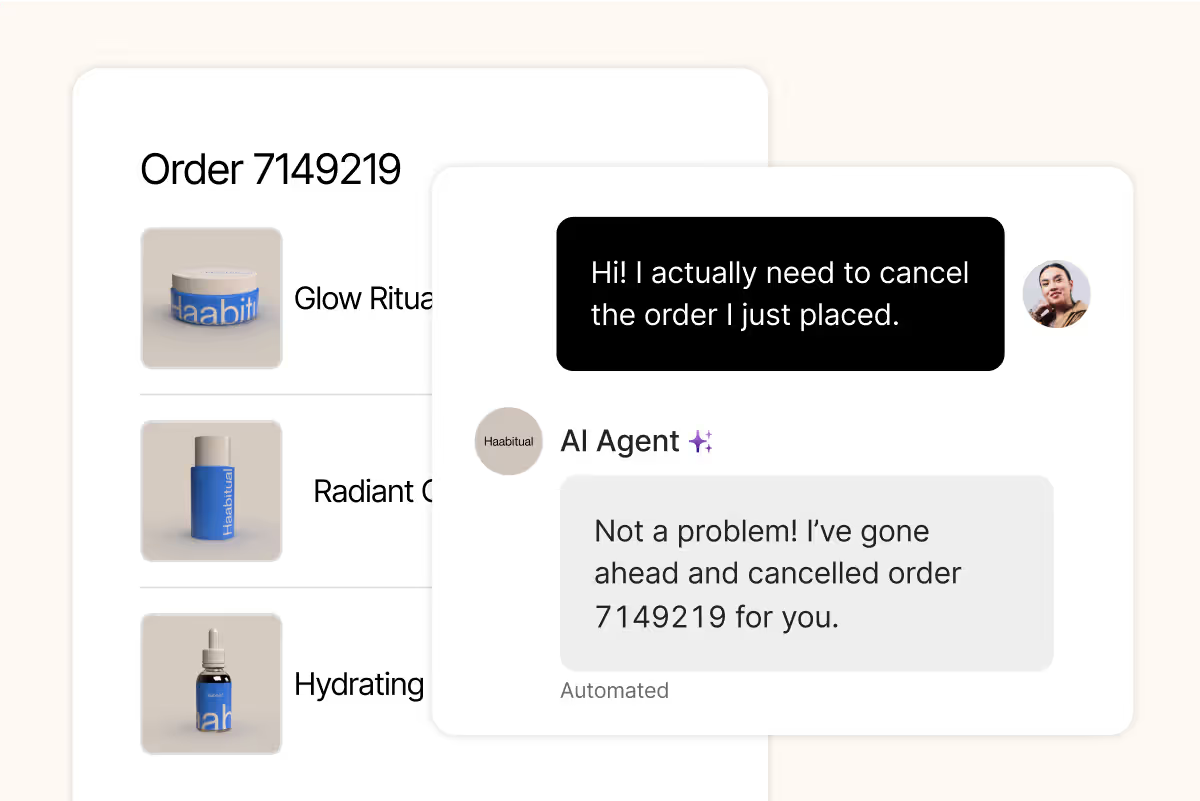
Read more: How to optimize your help center for AI Agent
Proactively guide shoppers
Be the compass for the wandering window shoppers and browsers. They might not know exactly what to get, but with the right nudge, you can guide them toward the right product and a fuller cart.
Try these chat prompts:
- Don’t know what size to get? Check out our sizing guide to get your perfect fit!
- Need help choosing the right carry-on? Here’s a quick comparison of our top sellers.
- We offer free shipping for orders over $60!
- What’s your skin type — dry, oily, or combination?
Offer discounts based on shopper intent
Sometimes, a discount is all a customer needs to take their order to checkout. Instead of storewide promo codes, use AI to offer tailored discounts to shoppers who show strong intent to buy. This can help reduce abandoned carts and leave customers with a great impression of your brand.
Here are some of the best times to offer a discount:
- A first-time shopper is hesitant because of the price
- A shopper adds an item to their cart, then asks about shipping or return policies
- A shopper asks if they should wait for a sale
Recommend products in real time
If shoppers can’t quickly find what they’re looking for, they’ll leave. Real-time product recommendations help resolve indecision and increase average order value.
Examples of when real-time suggestions drive conversions:
- A shopper asks for jeans in medium — AI suggests bestsellers in their size
- A returning customer mentions loving a nude-colored top — AI recommends similar or matching items
- A product is out of stock — AI suggests alternatives based on color or style

Hand off high-intent shoppers to live agents
High-intent questions are usually specific and goal-oriented — things like:
- What size should I get?
- How soon can this ship?
- Is this item still in stock?
When customers ask questions that directly impact their ability to purchase, it’s a strong buying signal. If they don’t get a fast response, they’ll probably abandon their cart.
So, how do you encourage shoppers to keep shopping?
Activate chat on your website and equip it with automated features, such as Flows, and/or conversational AI, like AI Agent.
No matter what setup you choose, always have a protocol ready to hand off to a human agent when needed.
In Gorgias, you can set up Rules or use AI Agent handover rules to automatically route conversations based on specific keywords, topics, or customer behavior.

2. Alleviate post-purchase concerns
After buying, customers may want to change their order or just need reassurance that everything is on its way.
If customers feel ignored during this critical window, you risk losing their business.
The easy fix? Eliminate friction, reassure customers, and make it easy for them to stay excited about their purchase.
Automate order status updates
Customers expect full visibility into their orders. Give them full access to this information, and you'll receive fewer WISMO requests.
Integrate your helpdesk with your 3PL or shipping provider to automatically send real-time updates on order status. If customers have an account portal, give them a tracking link.
Pro Tip: If delays are expected, automate messages to let customers know ahead of time. Being proactive keeps customers informed and reduces the need for reactive support.
Turn negative experiences into retention moments
When something goes wrong, like a delay, a lost package, or unexpected fees, it's how you respond that matters most.
Empower your CX team to act quickly. For example:
- Offer store credit, loyalty points, or free shipping perks to impacted customers
- Prioritize VIP or first-time buyers for fast-tracked resolutions
- Escalate critical post-purchase issues to senior agents
You can also use sentiment detection to flag frustrated customers early. Gorgias has built-in customer sentiment detection that automatically identifies tones like urgent, negative, positive, or even threatening language. You can create Rules that tag these conversations and route them to the right agent for faster handling.
Read more: Customer sentiments
3. Re-engage at-risk customers and reduce churn
Just because a customer is at risk doesn’t mean you’ve lost them. Identifying and re-engaging at-risk customers is one of the highest-impact things you can do to protect revenue.
Spot risk early
Pay attention to repeat patterns that signal dissatisfaction. Common early indicators include:
- Multiple shipping complaints
- Frequent refund or return requests
- Negative or urgent sentiment in support tickets
- Long periods of customer inactivity after purchase
Use sentiment detection and Ticket Fields (ticket properties) to tag these signals automatically. With this data identified, you’ll start to spot patterns that can help you address issues, giving customers a reason to stay.

Build recovery flows
Once you’ve identified your at-risk customers, use win-back strategies, like:
- Offering discount codes, loyalty perks, or free returns
- Sending personalized emails or messages acknowledging the issue and offering solutions
- Prioritizing conversations for your most experienced agents or account managers
When handled thoughtfully, a churn-risk customer can become one of your strongest advocates because you showed up when it mattered most.
4. Build loyalty by surprising your best customers
Don’t forget, there are already customers who love you! These loyal customers don’t just come back to buy again — they bring friends, amplify your brand, and give your business stability when you need it most.
Identify and prioritize VIPs
Use customer data to identify customers who purchase frequently, spend more, or have referred others. Tag them as VIPs in your helpdesk so that their requests are prioritized.
For example, in Gorgias, you can use Customer Fields (customer labels and properties) to group your customers under:
- VIP
- Repeat purchaser
- High lifetime value
- Promoter
When you know who your top customers are, you can offer more personalized service and make sure every interaction strengthens their connection to your brand.
Create brand advocates through small gestures
You don’t need to offer huge discounts to let customers know you appreciate them. Small, thoughtful gestures often make the biggest impact:
- Send handwritten thank-you notes with their orders
- Offer a free gift, upgrade, or loyalty perk after a milestone purchase
- Include a referral code they can share with friends
- Feature loyal customers on your social media channels (with their permission)
If you’re using macros and automations, you can even trigger some of these surprise-and-delight actions automatically, making it easier to scale while keeping the personal touch.
Make revenue your outcome at any time
We know how overwhelming uncertain times can be. It’s easy to think you need to reinvent your entire strategy just to keep up.
But the truth is, you already have what you need. You have a team that knows your customers. You have conversations happening every day that can protect, nurture, and even grow your business.
By grounding yourself in what’s already working and creating proactive systems, you can turn uncertainty into strong and steady growth.
{{lead-magnet-1}}

Building delightful customer interactions starts in your inbox



